On May 14th, I was able to cross off an entry on my “Gardens To See Before I Die” list. It was a supreme pleasure on our spring road trip from Toronto to New Jersey for my husband’s college reunion to detour eastward in order to visit Garden in the Woods in Framingham, Massachusetts 20 miles outside Boston. I had heard so much over the decades about this garden featuring native New England plants that I couldn’t imagine being so close in spring and missing it. So we expanded our trip to spend two nights in Framingham in order to meet old Wooster, MA friends for dinner and visit the New England Botanic Garden (formerly Tower Hill Botanic Garden) in Boylston, but more on that later. Right now, let’s head into the parking lot on 180 Hemenway Road in the leafy suburbs of the town of Framingham. Walking towards the visitor entrance, we pass a spectacular carpet of mayapple (Podophullum peltatum) under airy pink-shell azalea (Rhododendron vaseyi) and flowering dogwood (Cornus florida) and I’m delighted to discover……
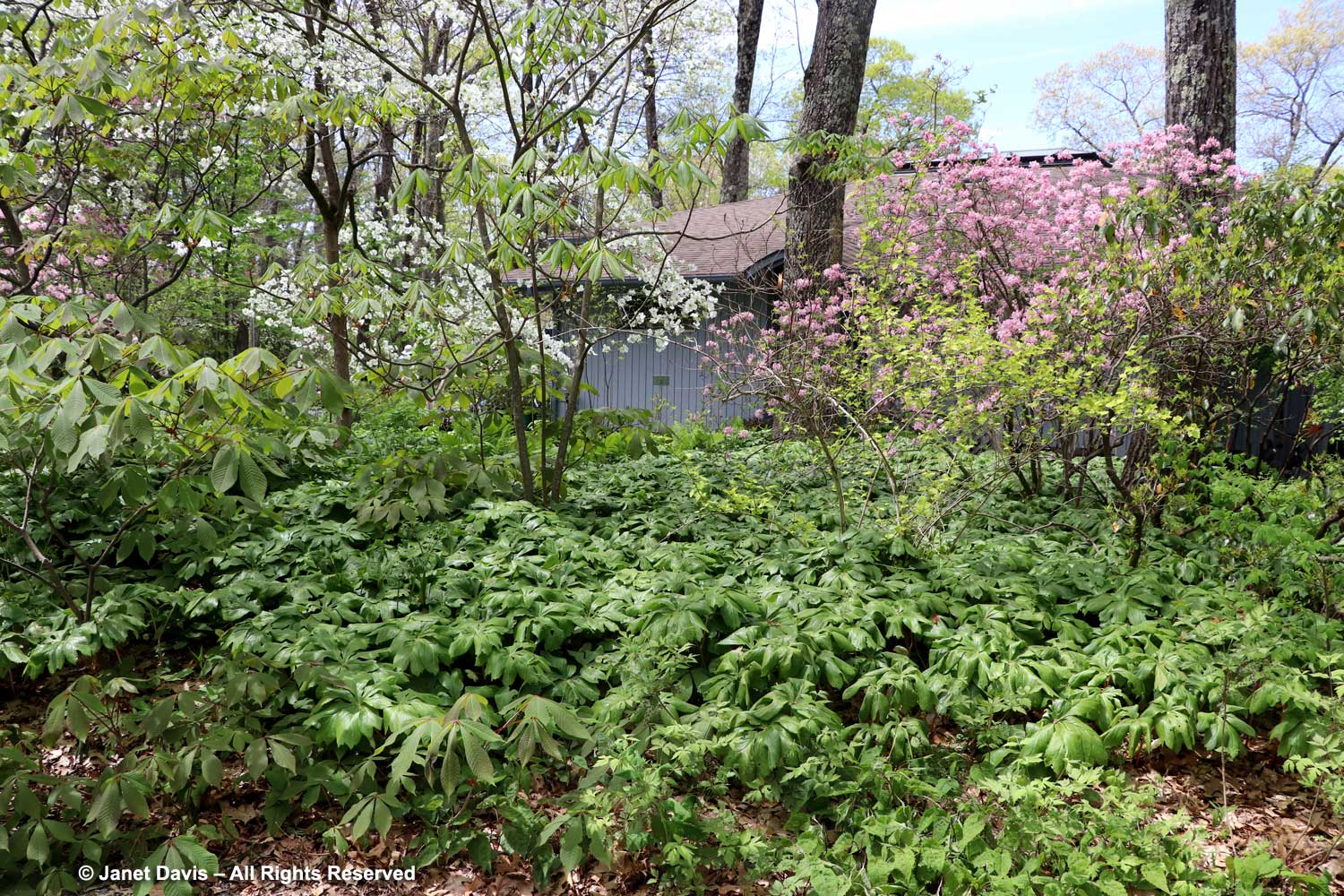
…… that I can photograph a shy mayapple flower without getting down on my hands and knees!
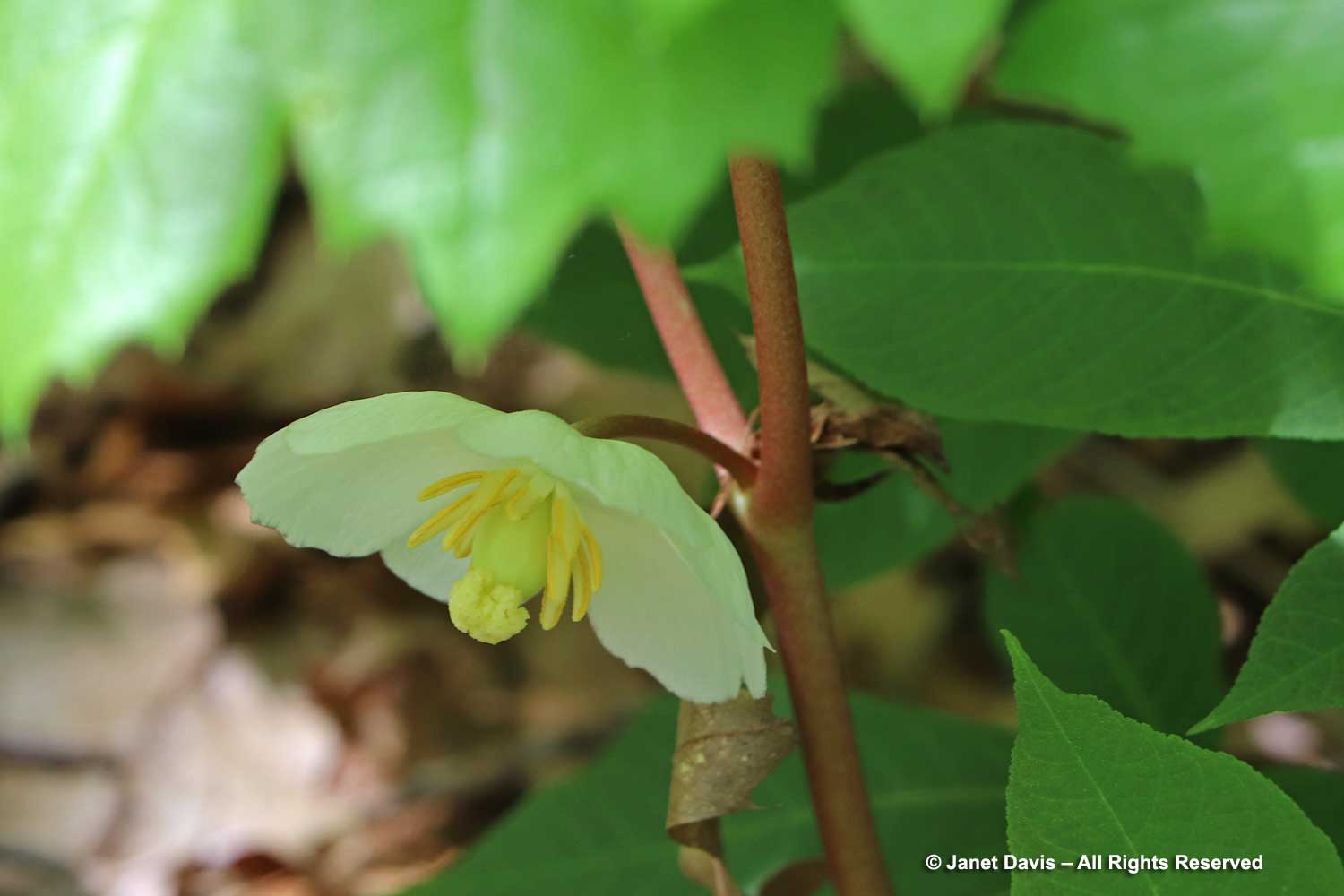
The flowers of pink-shell azalea, endemic to the Appalachian highlands. are simply exquisite.
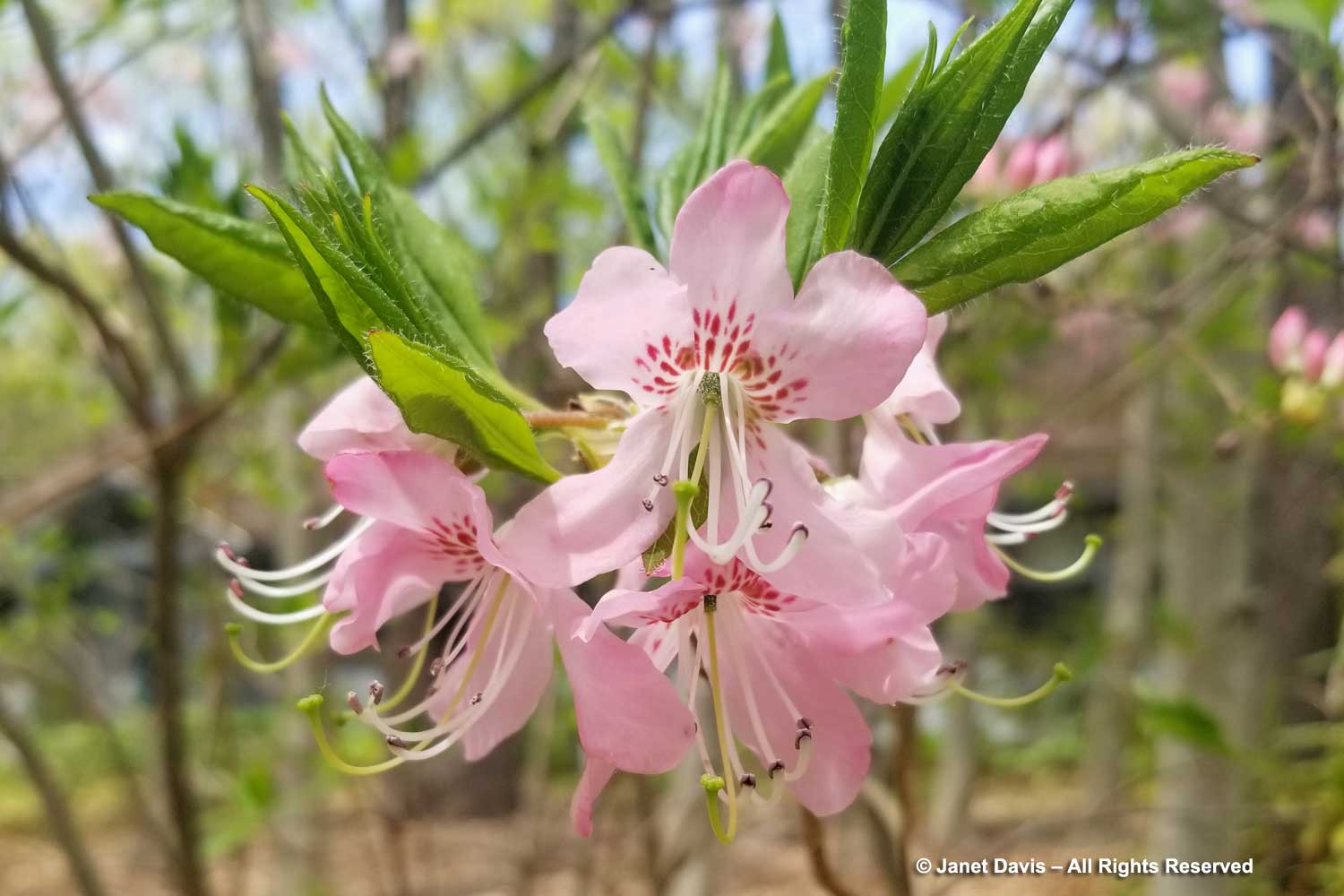
I spot a little crested iris (I. cristata) in the entrance gardens and I am excited about what is to come!
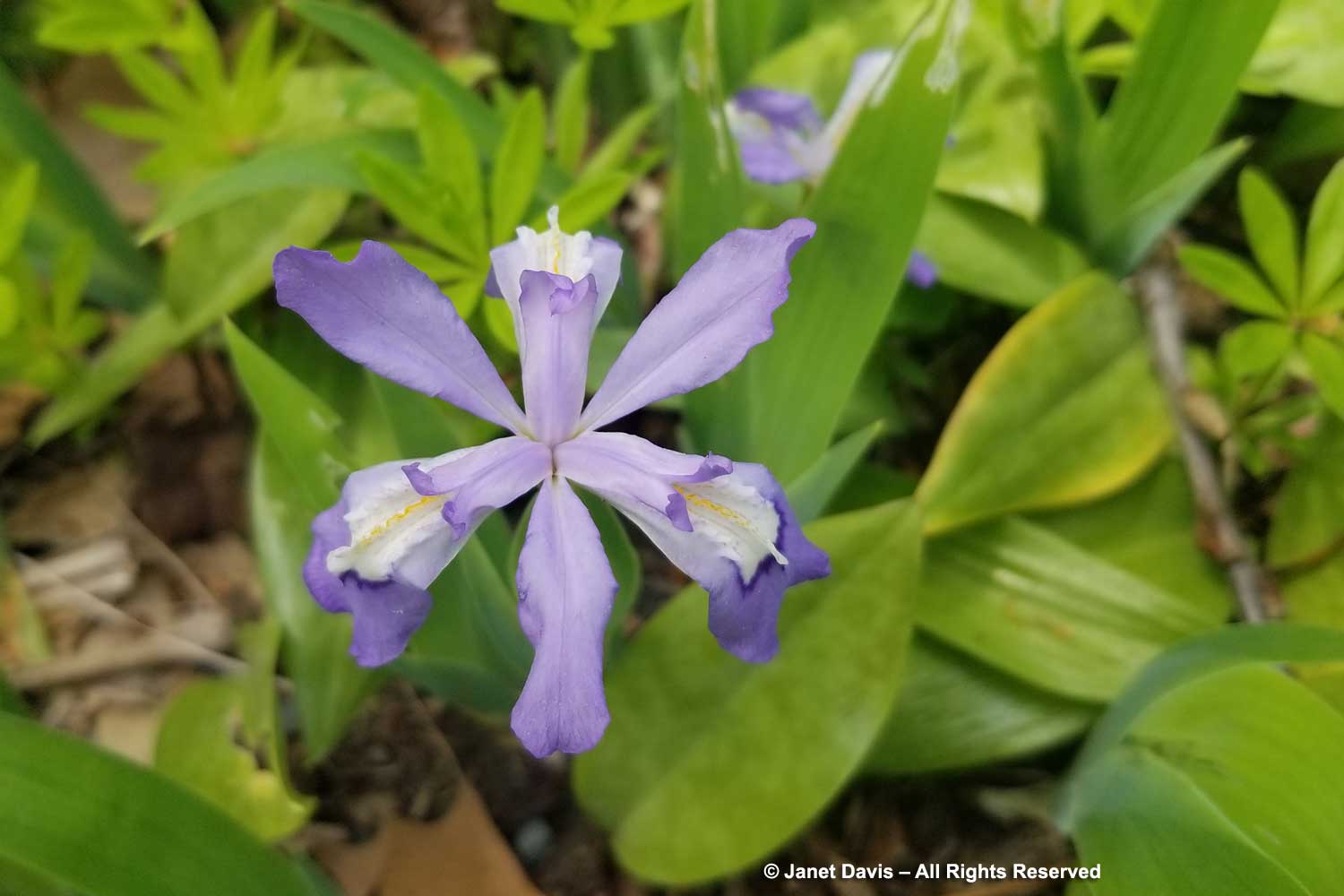
We pay our admission and I take a fast glance around the beautiful little gift shop and the plants for sale, below, before heading out. (I’ll talk about the history of the garden and Native Plant Trust later, but the plants are grown at the Trust’s native plant nursery Nasami Farm 93 miles west in Whately MA.)
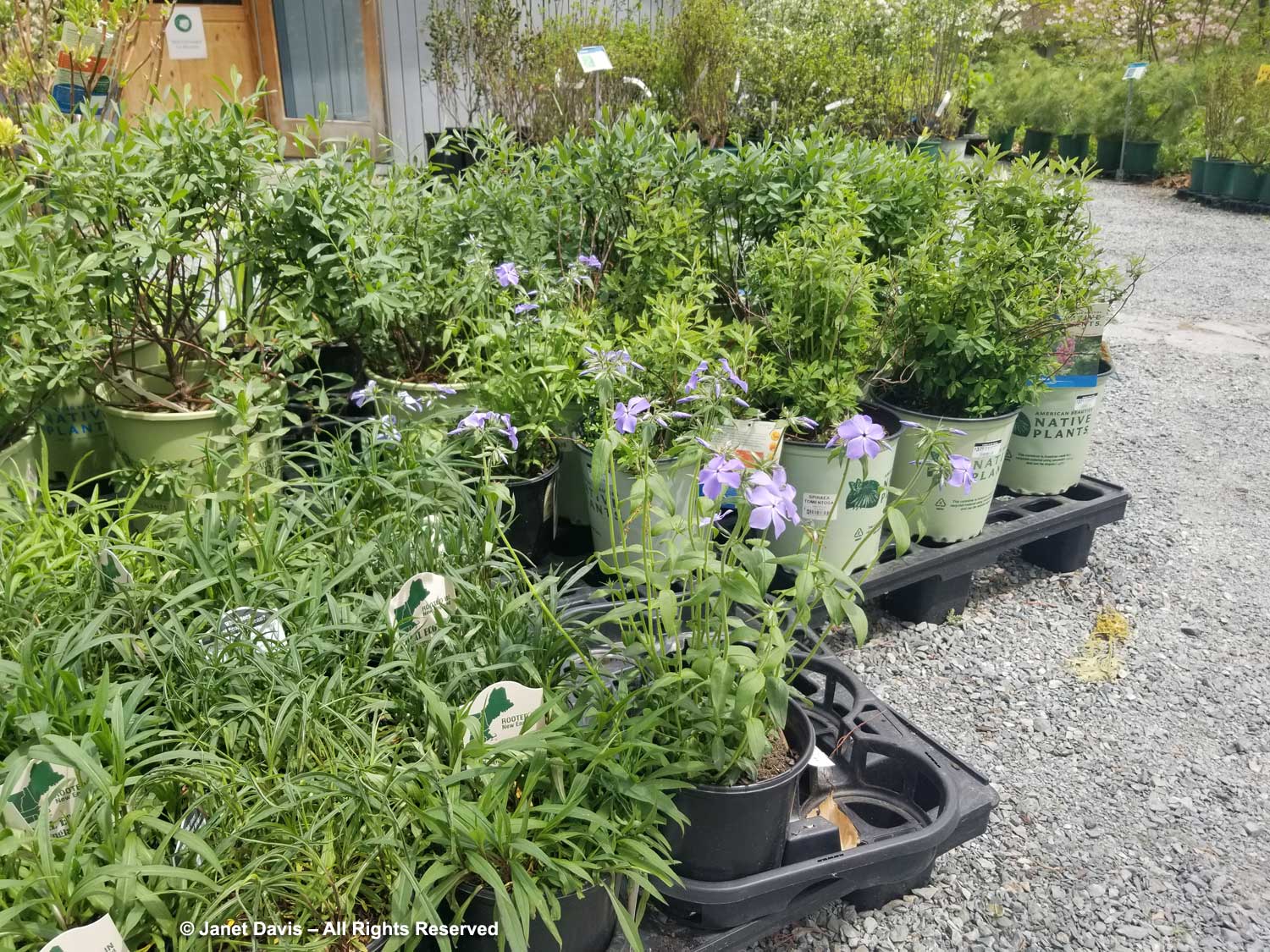
It is 1:15 pm when we start our visit and we will spend 2.5 hours here on the main loop, which is probably an hour less than the time I would like to have had to explore the various satellite trails. I’ve shown our route with red arrows on the map below. (Note that the garden recommends an hour to do the mile-long main loop, but that might be for visitors without cameras!)
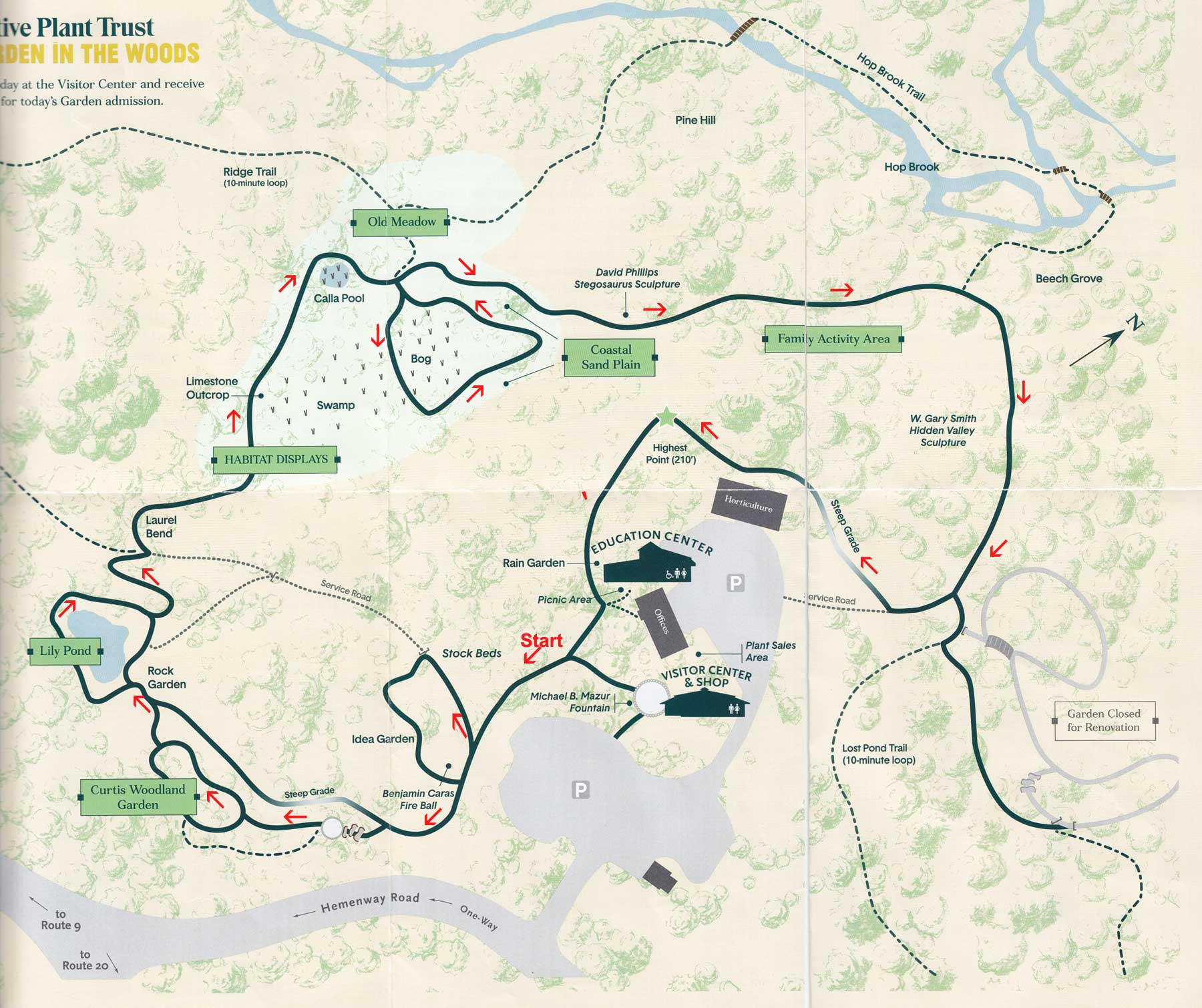
I photograph the What’s in Bloom display for the various garden areas so I can refer to it as we make our way around. We are at peak bloom for the spring ephemerals, including trilliums; in fact the garden boasts a collection of 21 species of trillium!
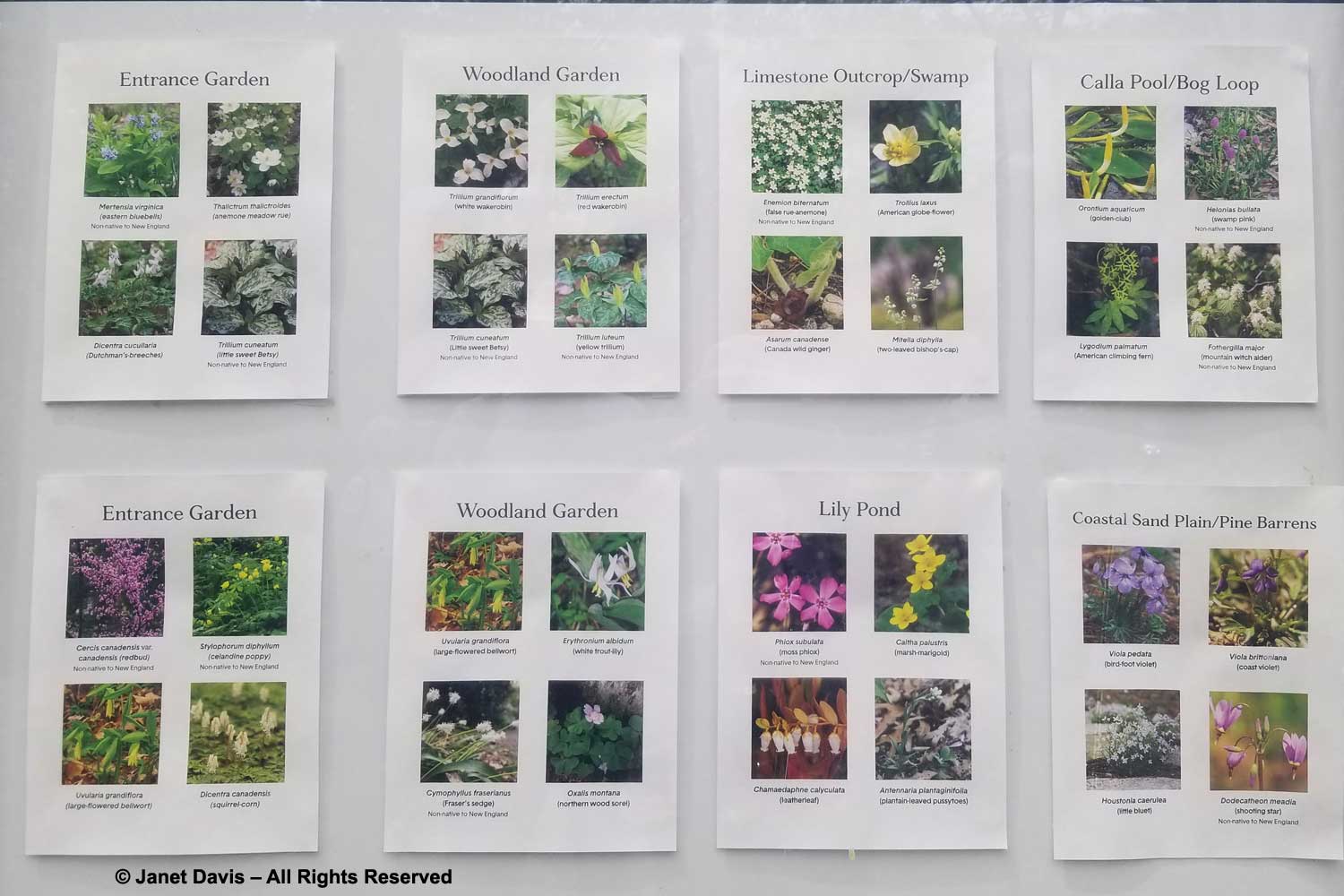
The path is wide and flat here and bisects sun-dappled woodland with lots of signage to identify the native plants, like the spotted cranesbill (G. maculatum), below.
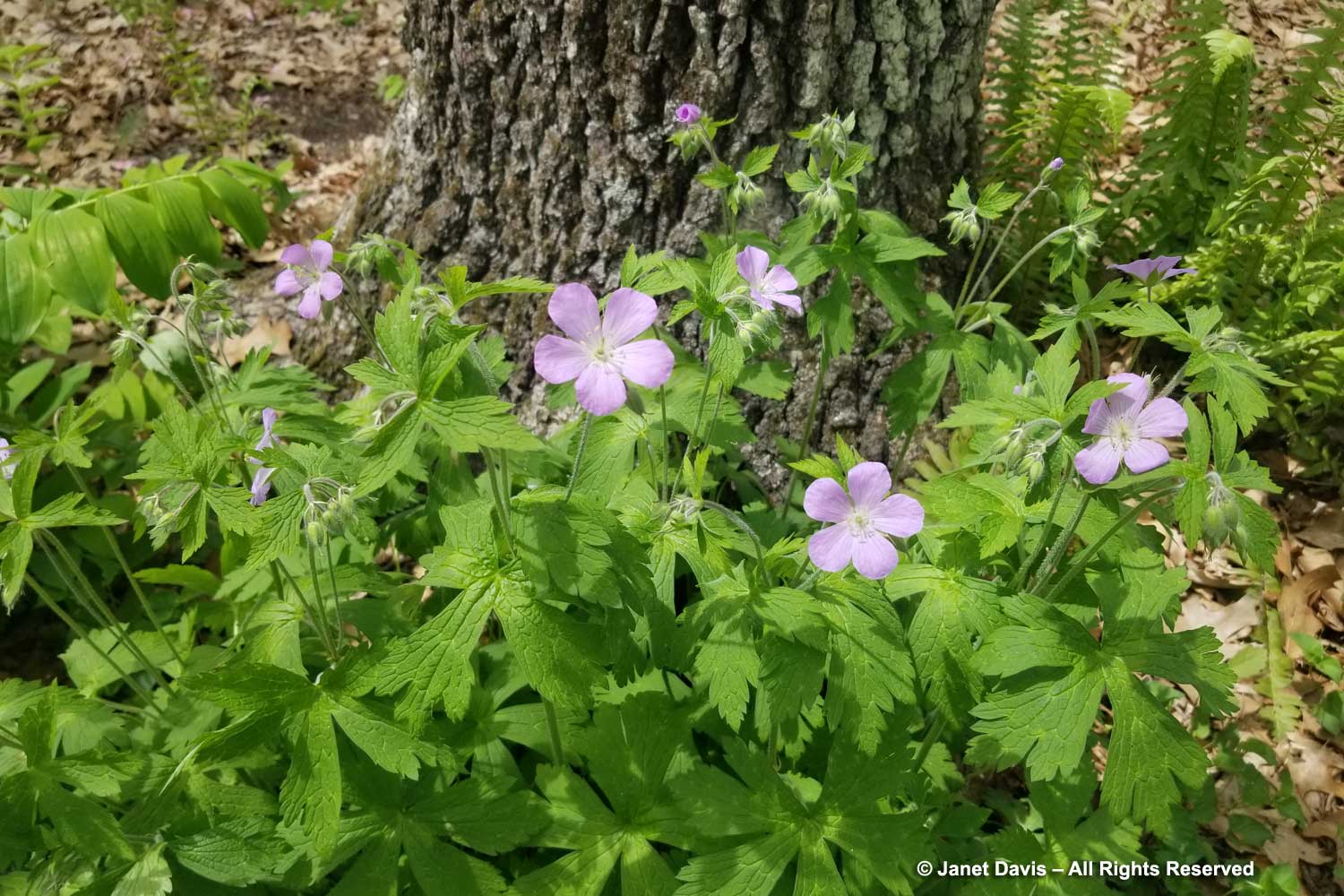
You can see brown autumn leaves between the plants – they are left on the garden to act as nature’s mulch. Now…. imagine this as your wild back yard, for that’s what it was to Cornell-educated landscape designer Will C. Curtis (1883-1969). One of his foundational roles was with Warren Manning, sometimes called the “Dean of Landscape Architecture”, renowned for his informal, naturalistic ethos in design. Later, he worked as the general manager of a tree farm in Framingham, and in 1931, while out hiking, he came upon this 30-acre piece of land in the rural north part of the city. Owned by the Old Colony Railroad and used as a gravel mine, it featured “undulating eskers, tumbling brooks and varied woodland with two bogs and one pond, plus an ever-flowing spring” (Dick Stiles).
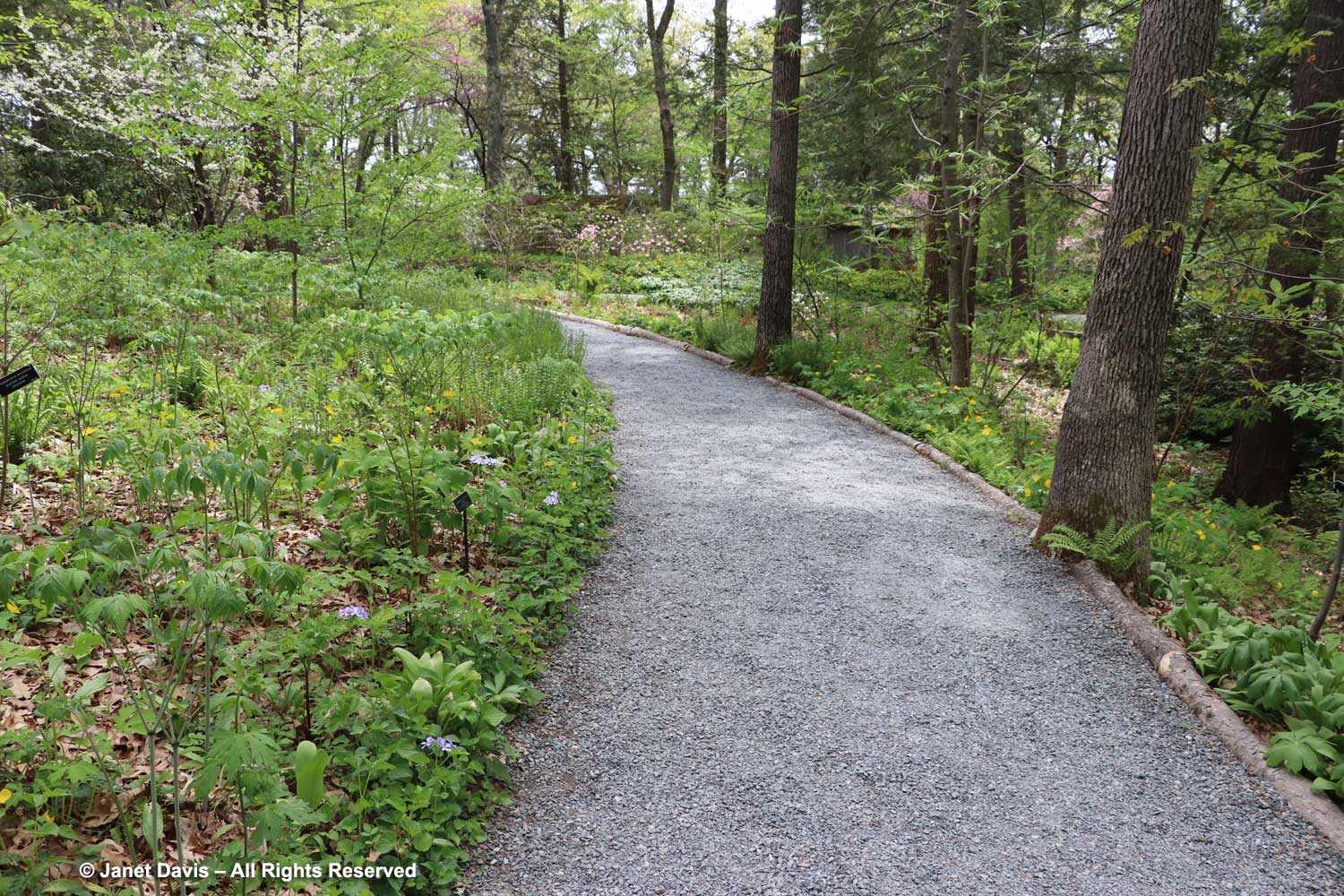
Will Curtis was able to purchase the land for $1,000. At 48 years of age, he set about building a rustic cottage, felling trees, clearing garden areas, laying out trails, expanding the lily pond and making a rock garden. Soon, with the help of volunteers, the Garden in the Woods was opened to the public. In 1933, Curtis was joined by Howard O. (Dick) Stiles and in 1936 they began a full partnership, giving tours, selling plants and raising exotic, award-winning plants under glass. Over the next 30 years, Will Curtis (right, below) and Dick Stiles (left) became experts in native American plants while maintaining seed and information exchanges with international botanical gardens.
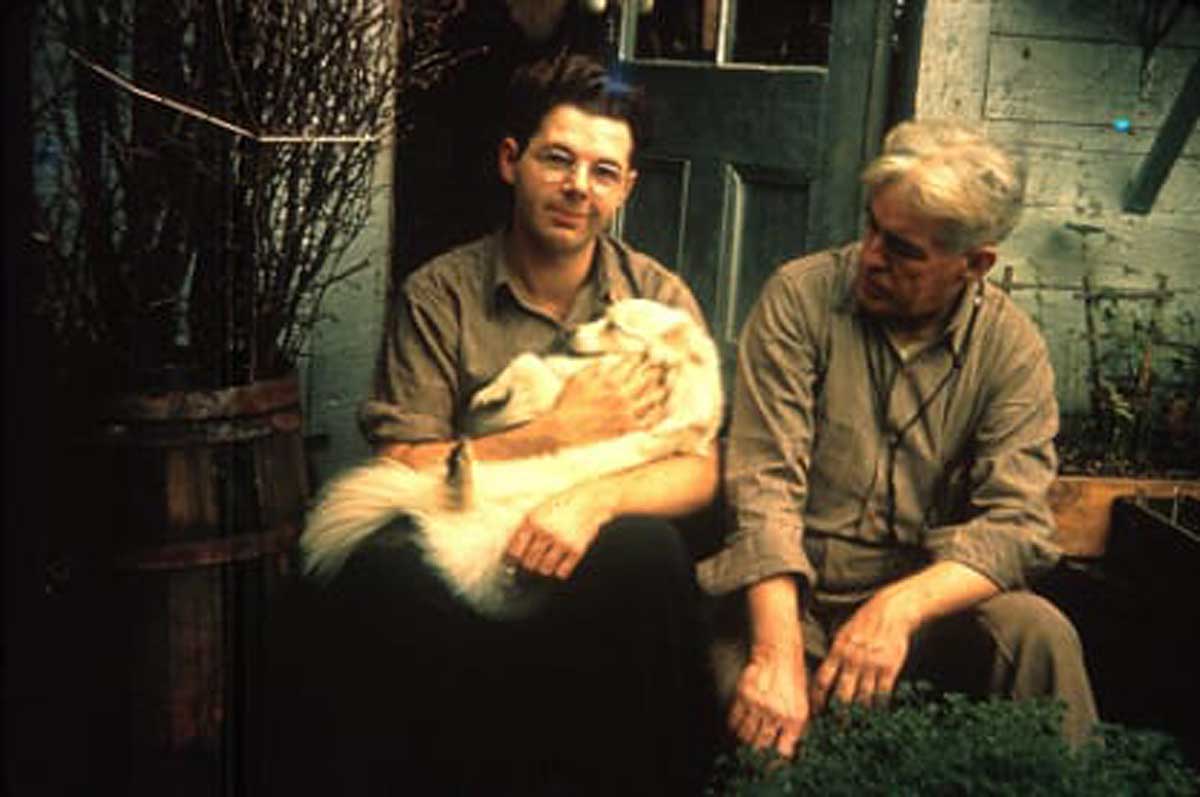
As Framingham grew and houses sprang up nearby, they turned down offers to sell to developers. In May 1965, the decision was made to transfer the Garden in the Woods to the New England Wildflower Preservation Society, with Will and Dick staying on as director and curator respectively. But after a period of ill health, Will Curtis died in 1969 at his home in the garden. As Dick would write later, “This man was a most unusual character; rugged, determined, resourceful, undeviatingly honest with no use whatever for so-called ‘diplomacy’. He was a man with vision, a true artist who knew exactly what he wanted and went to any amount of time and labor to achieve it, whether doing landscaping for a client, or working at the Garden. He never used a plan—not once—for it was all in that brain that could envision and feel and know just how it should be.”
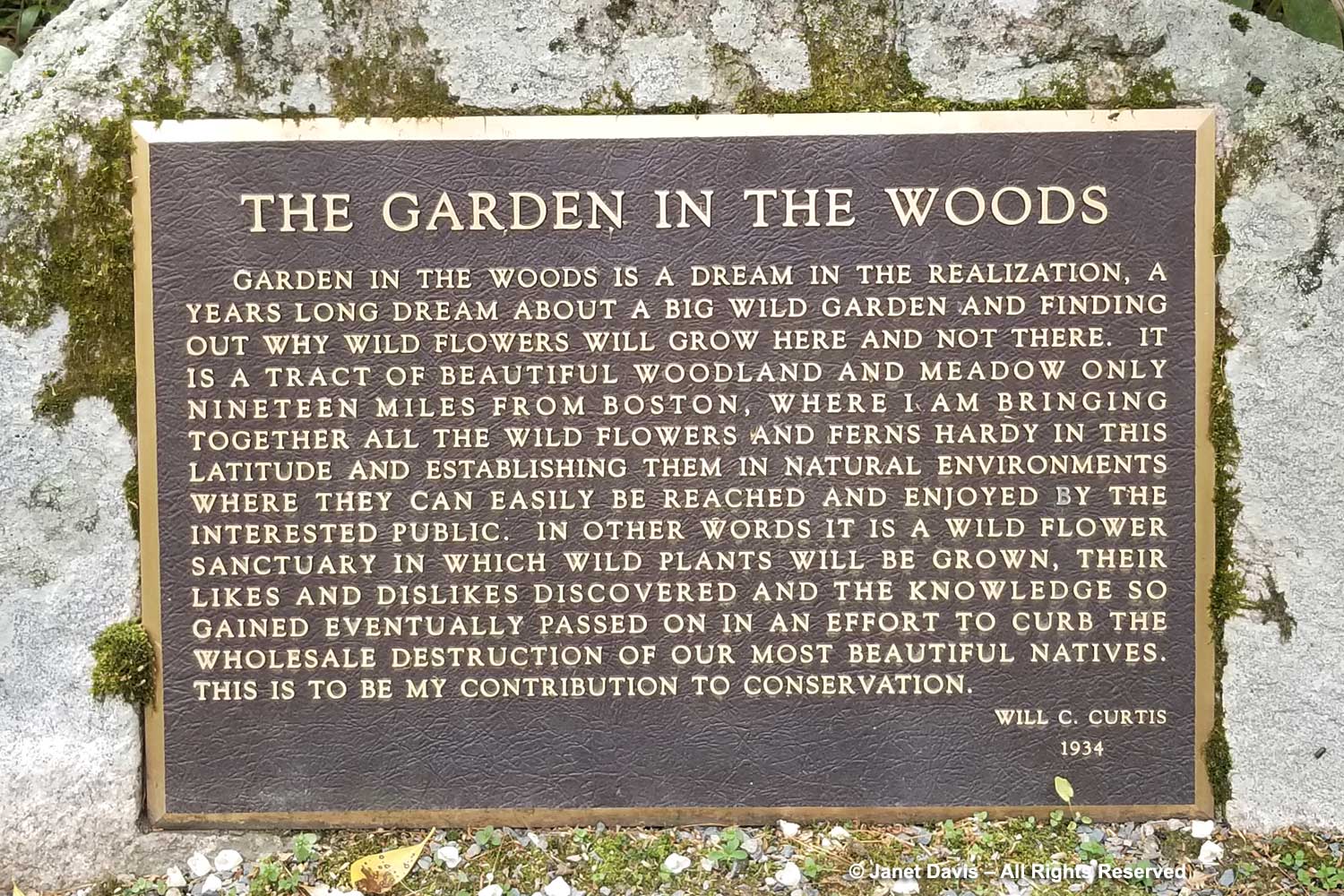
Today, the expanded 45-acre garden is owned by the Native Plant Trust, the new name as of January 2019. According to director Uli Lorimer in an interview with Margaret Roach, the name was changed from the New England Wild Flower Society “to better align with the conservation, horticulture and education work we have been doing for years, and will continue to do in the future”. But for the average visitor, it’s simply a place to be inspired with the native plants of New England and how to use them in design, like the yellow wood poppy (Stylophorum diphyllum) with Jacob’s ladder (Polemonium reptans) below. On that note, just days before our visit, Uli Lorimer’s book ‘The Northeast Native Plant Primer – 235 Plants for an Earth-Friendly Garden’ was published
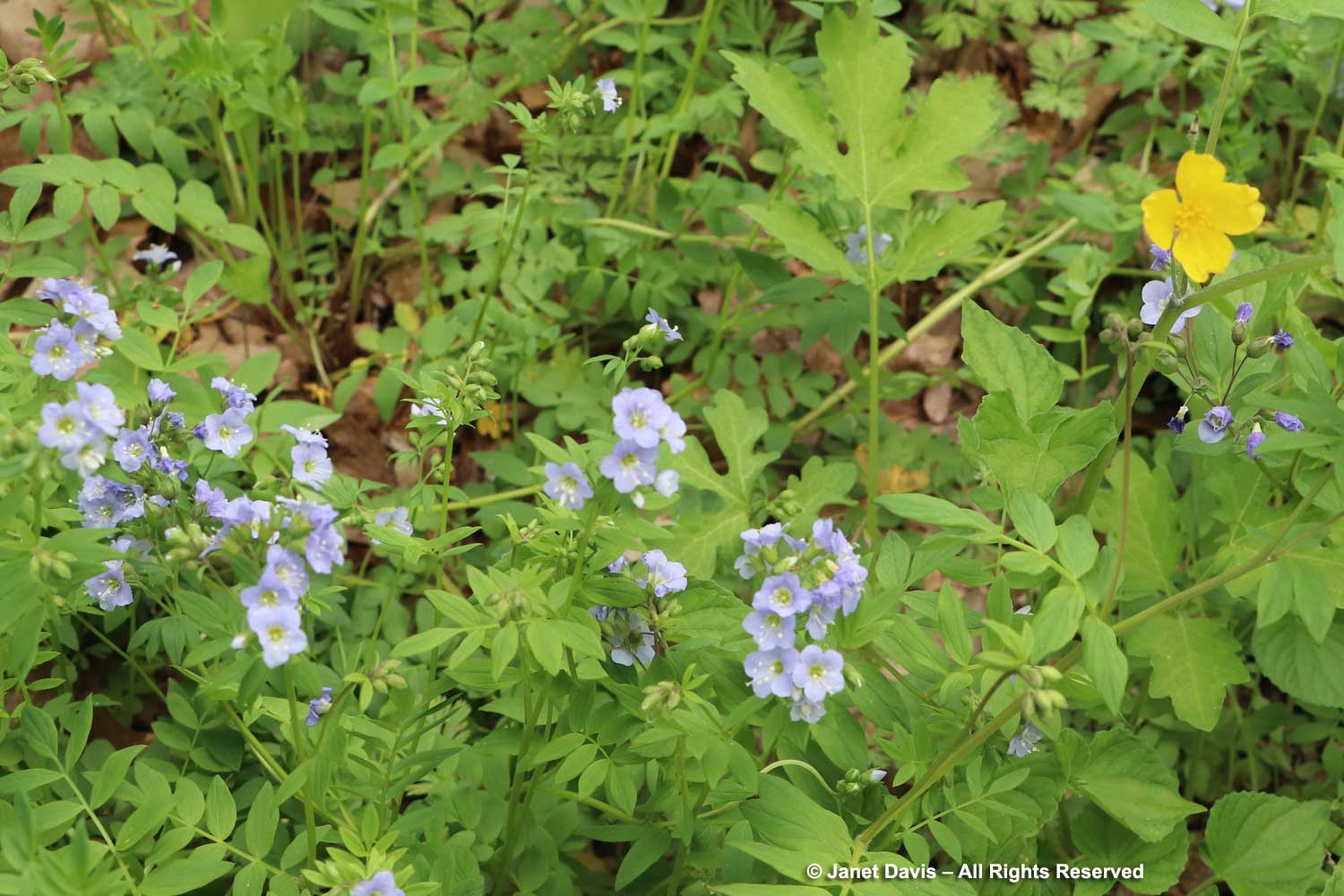
I’m excited as I spot my first trillium, large toadshade (Trillium cuneatum)!
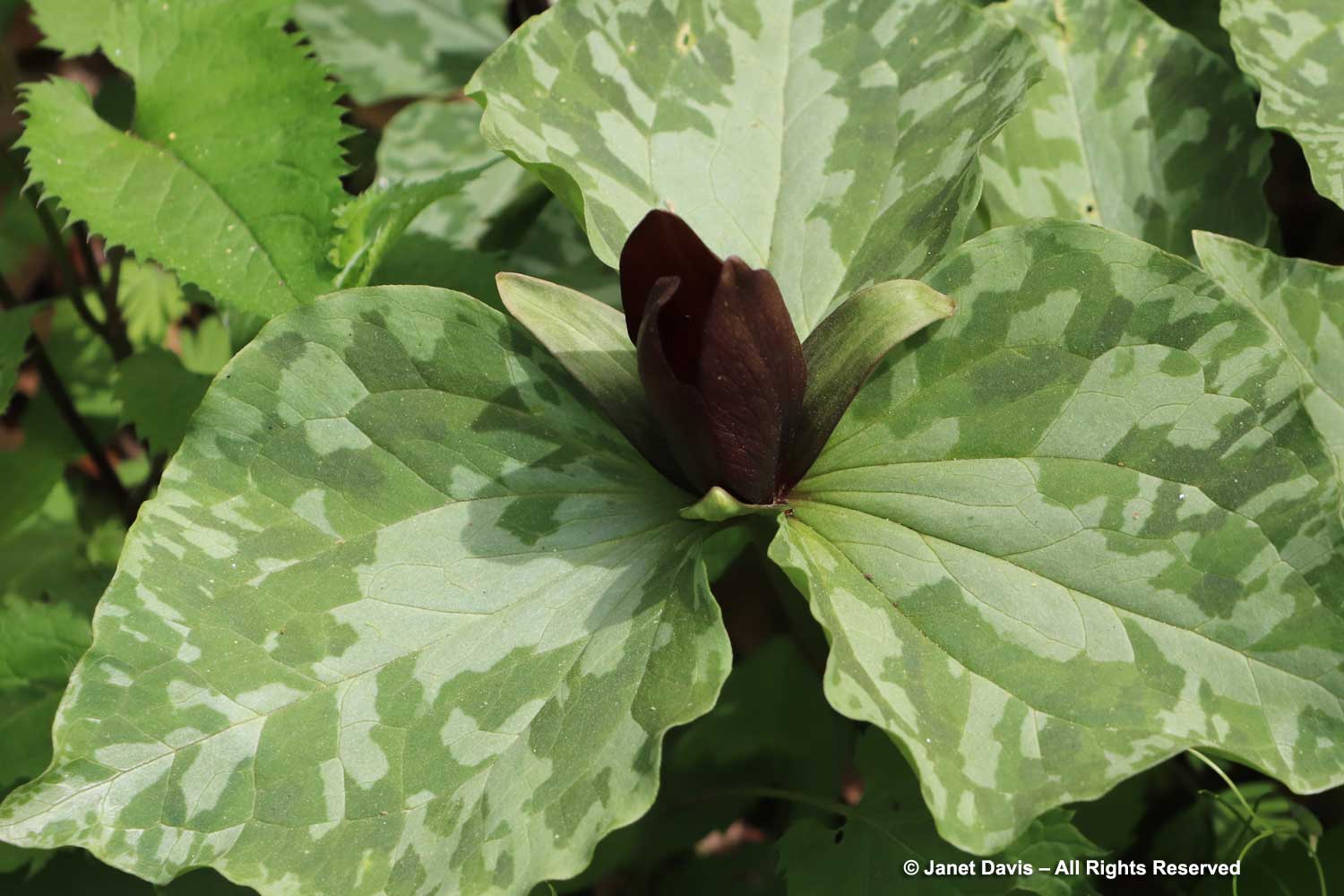
Some plants are familiar, like the white foamflower (Tiarella cordifolia), below with Christmas fern (Polystichum acrostichoides), while others….
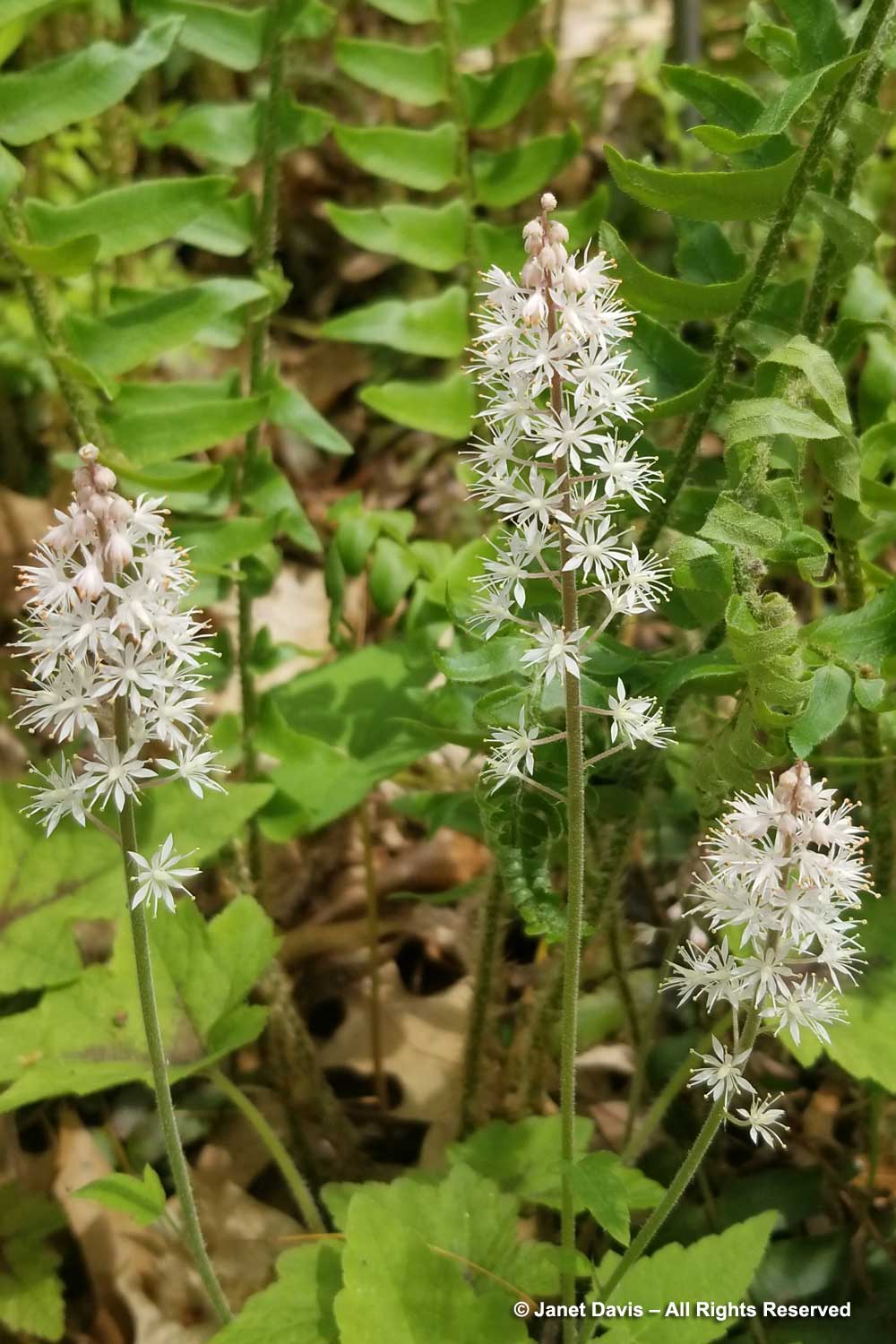
…. like the goldenseal (Hydrastis canadensis)….
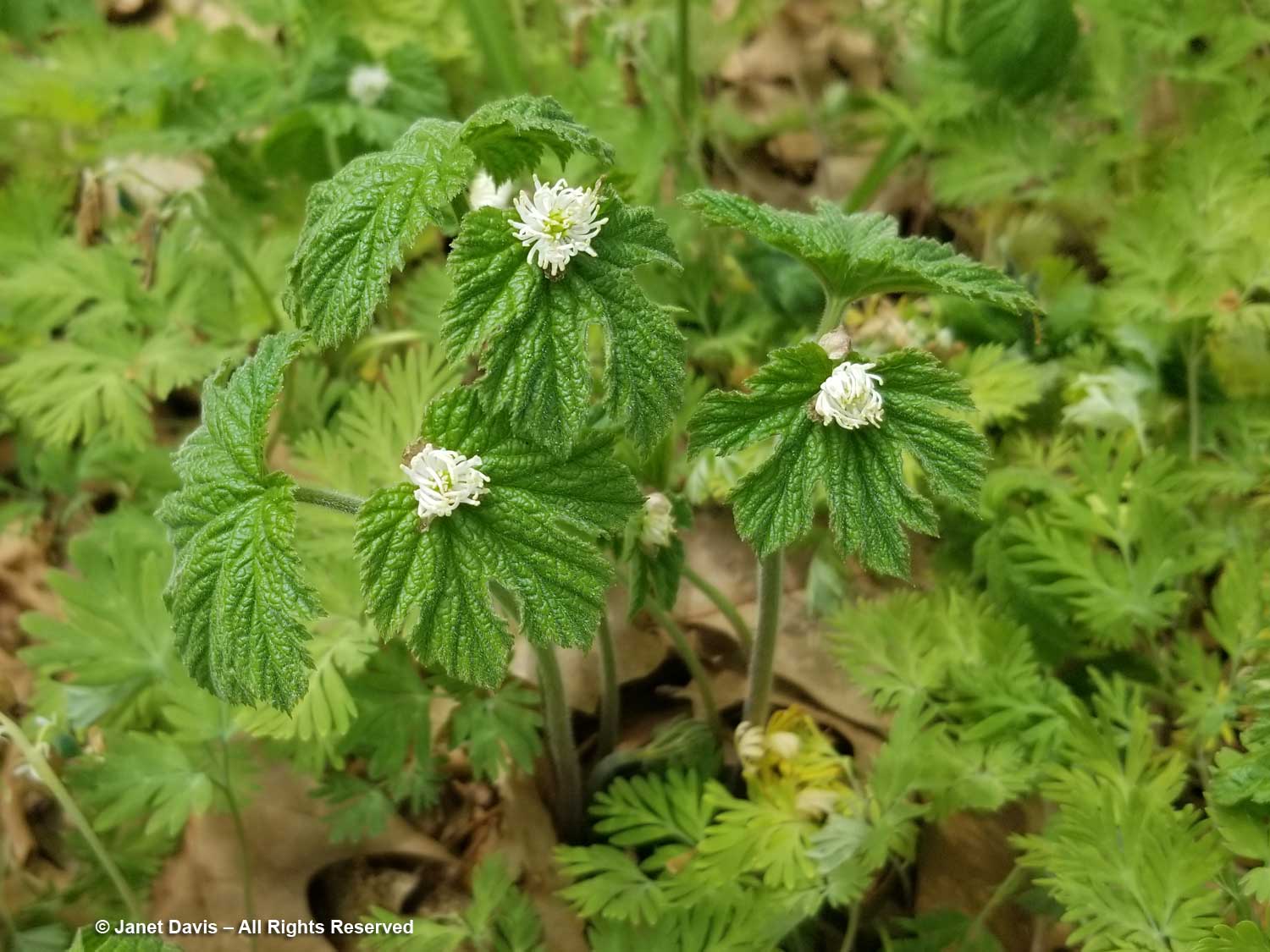
…. and the green-and-gold (Chrysogonum virginianum var. brevistolon) are not.
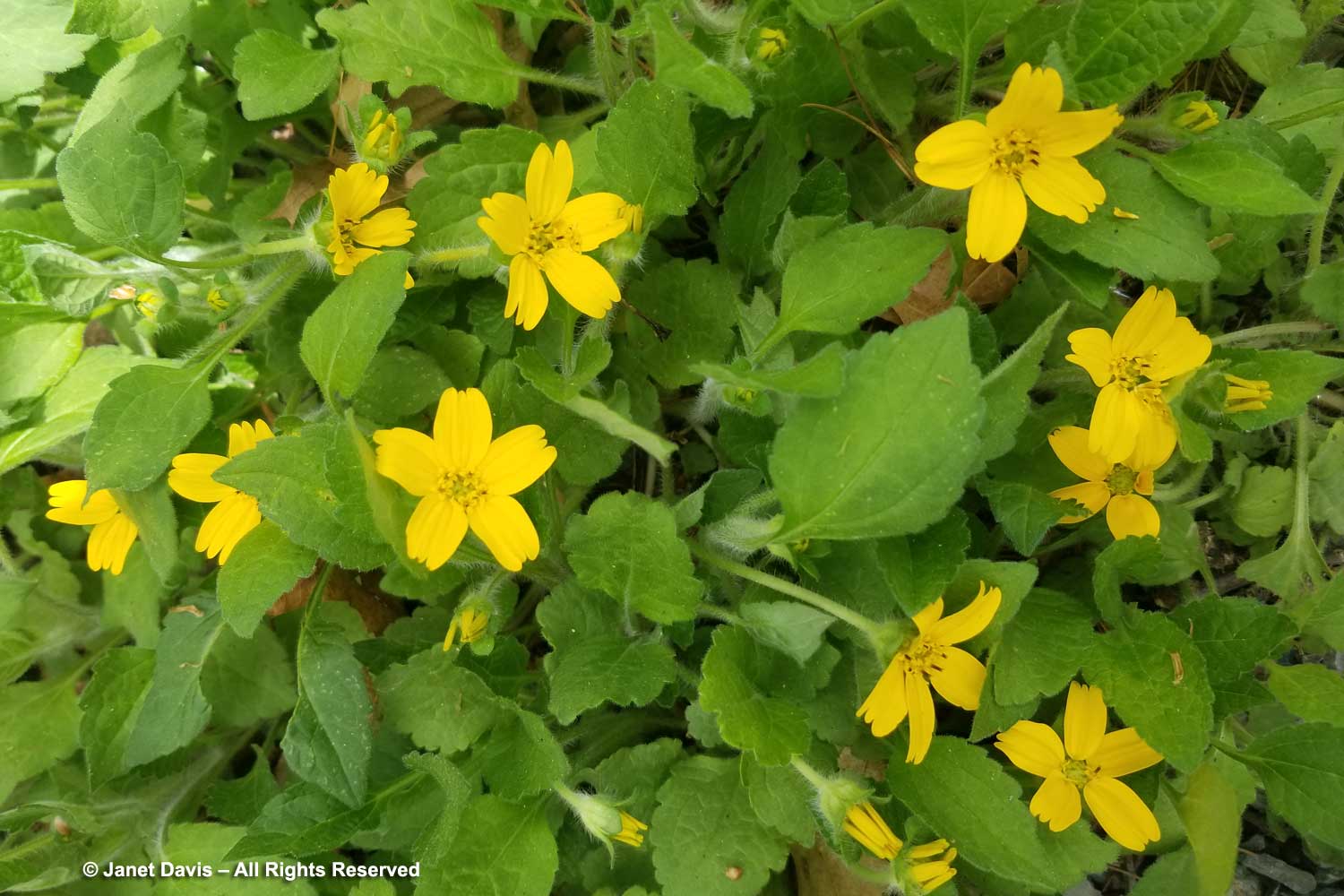
Not far along the trail, we check out the Idea Garden, with its residential scale.
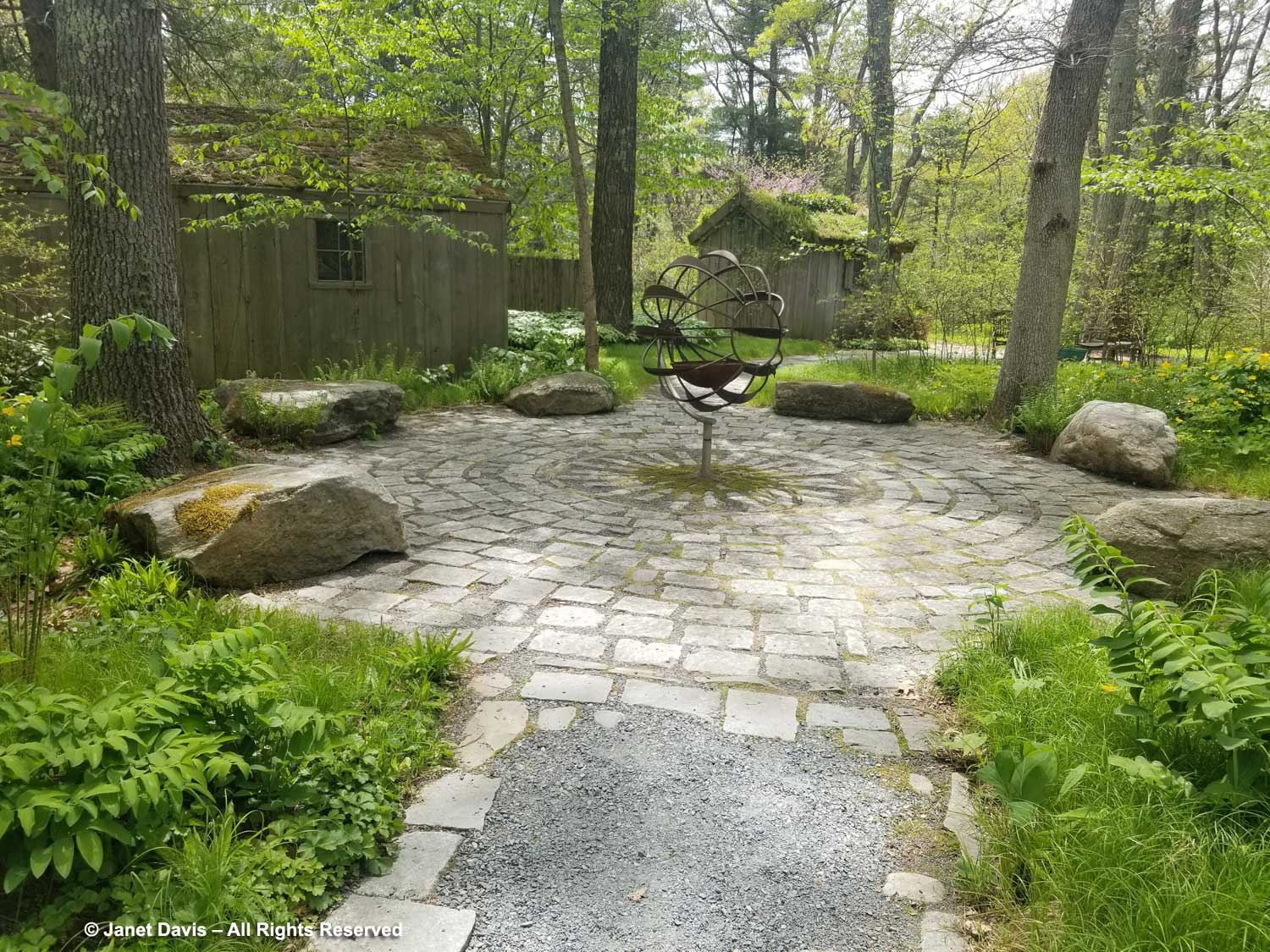
I love the shed’s green roof of native plants, with chokeberry and redbud tree in flower at right.
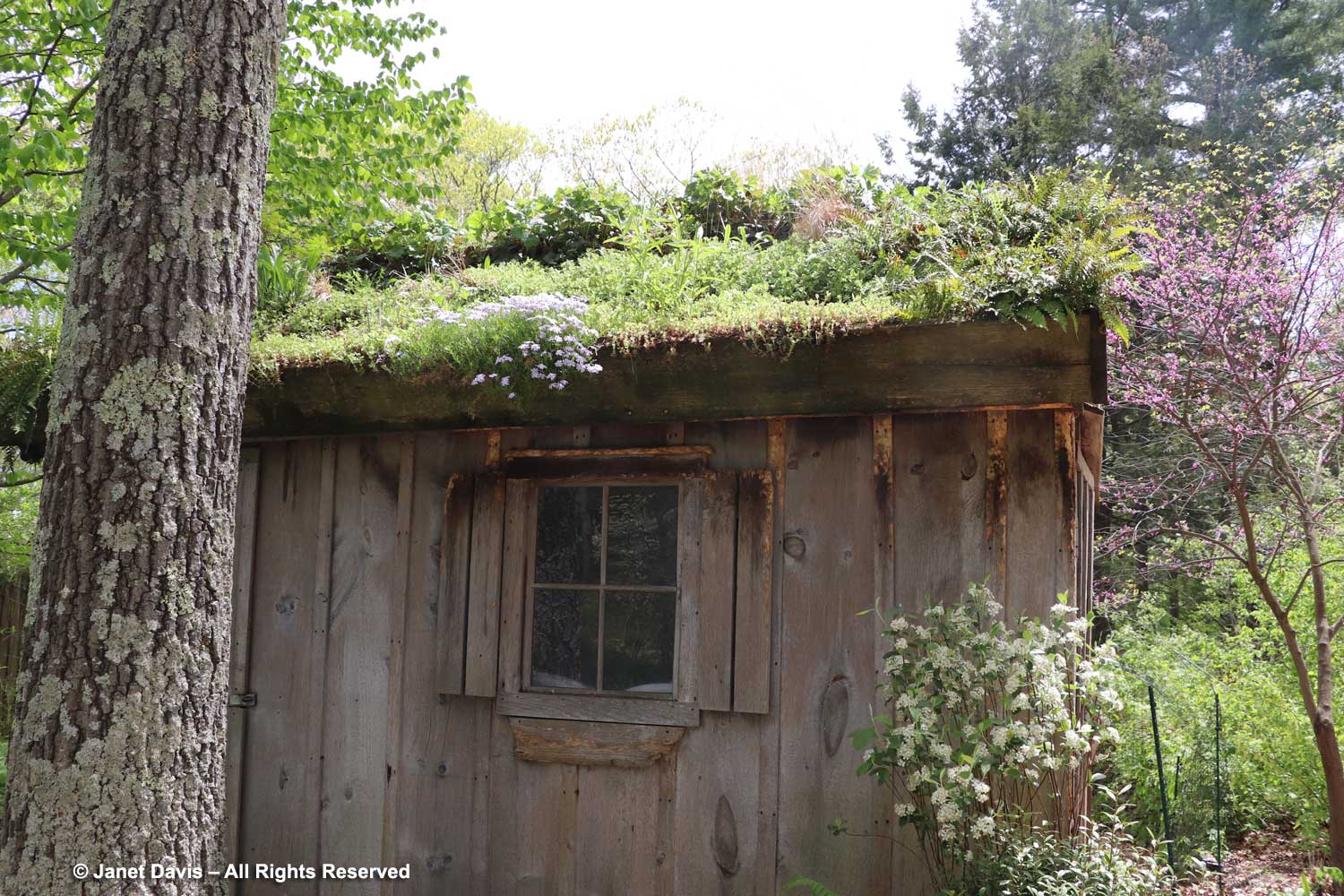
Although the garden is virtually 100% native, I note a little drift of Anemone nemorosa ‘Vestal’ alongside the ferns, Solomon’s seals and wood poppies (one of the ‘well-behaved’ non natives that made its way in).
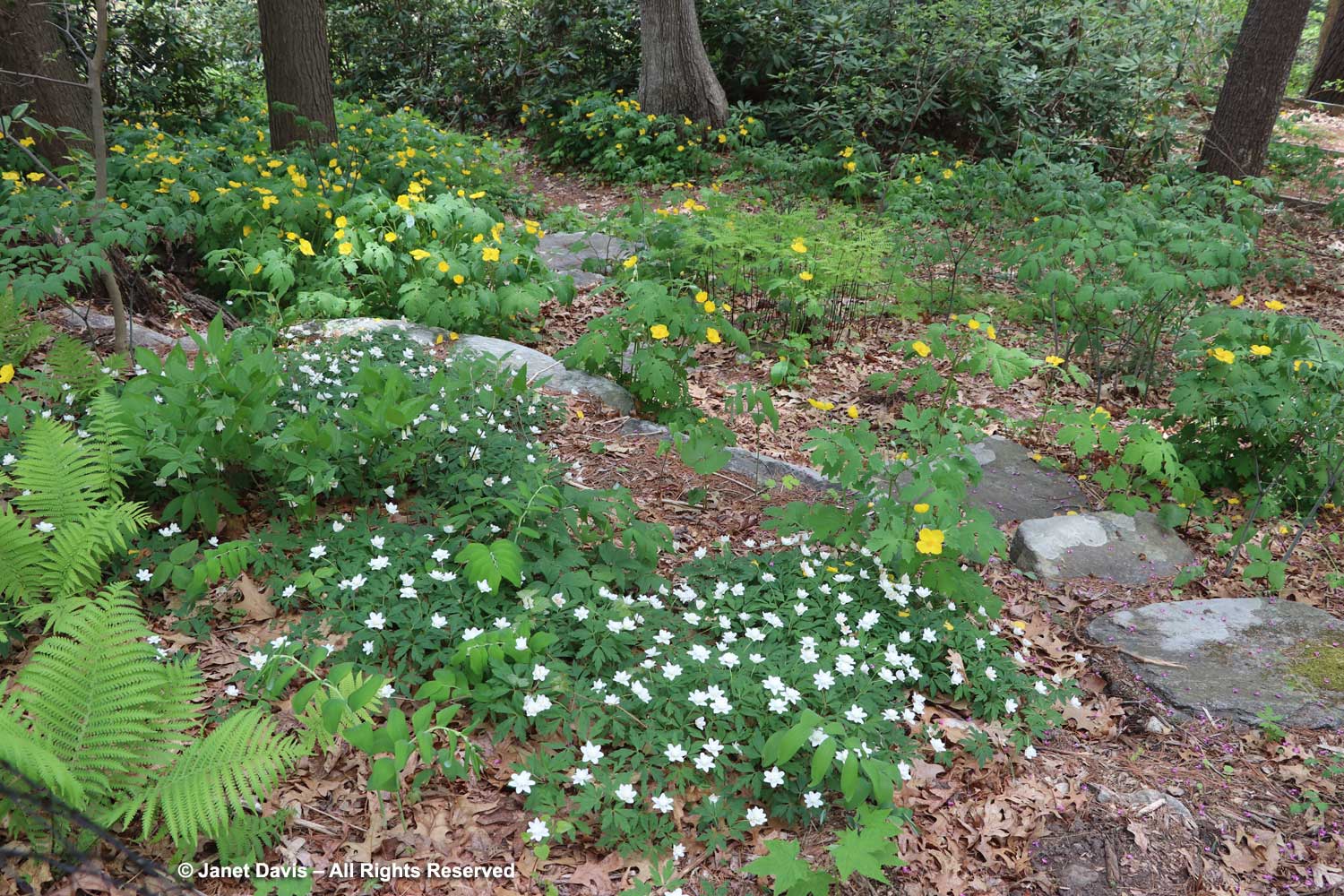
Pink flowering dogwood (Cornus florida ‘Rubra’) lights up the woodland.
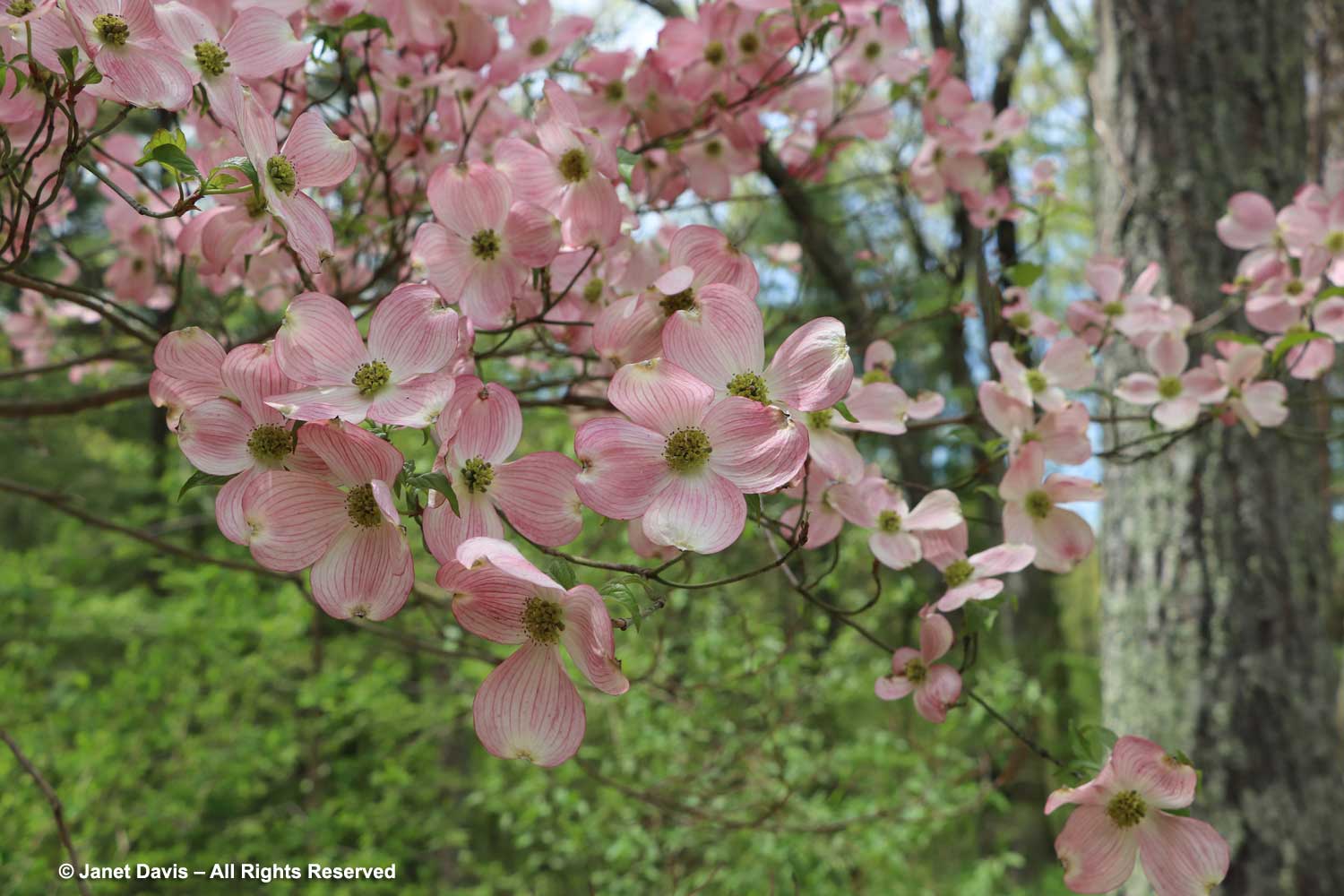
For visitors looking for a native lawn substitute, swards of Pennsylvania sedge (Carex pensylvanica) are there to inspire!
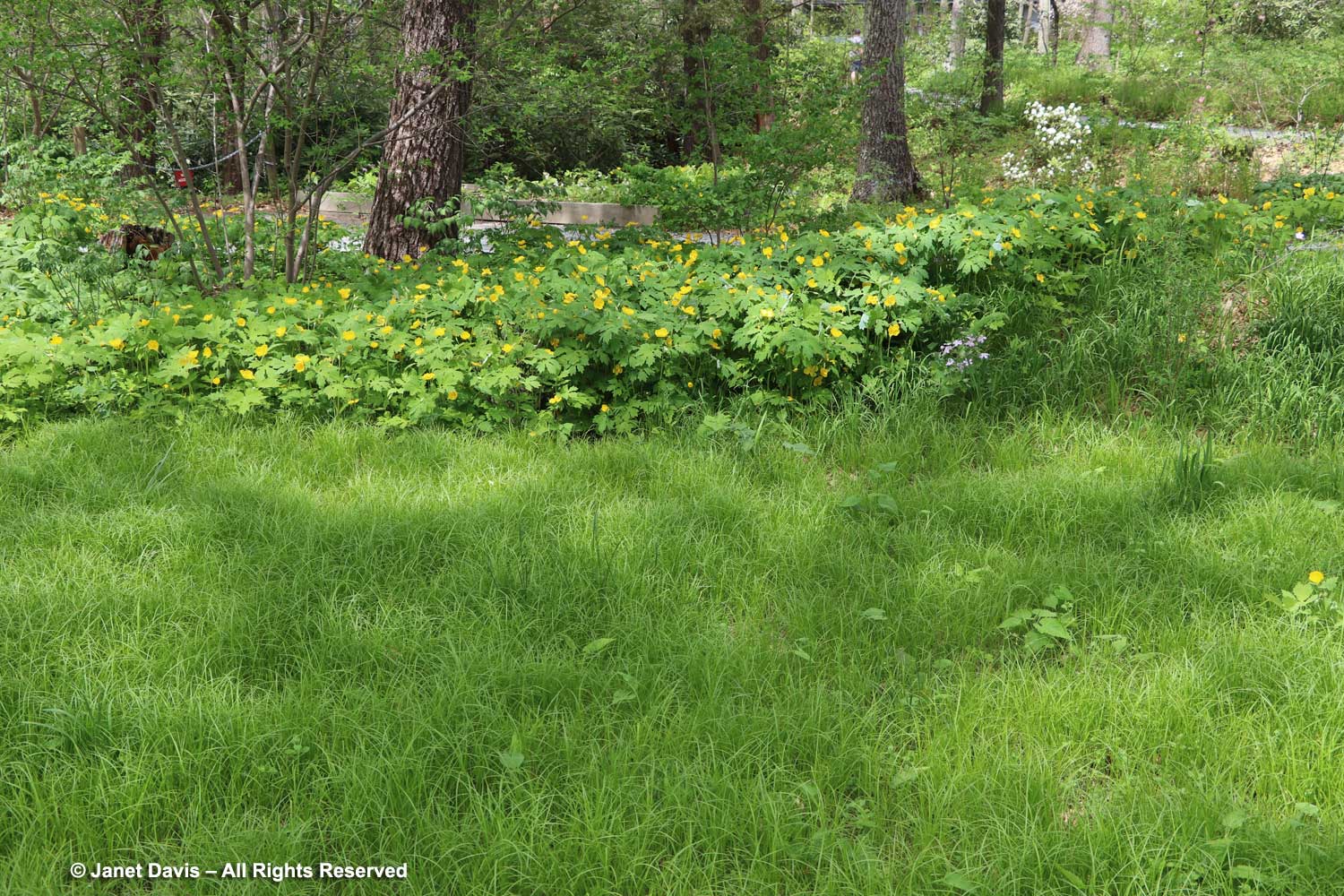
Native plant cultivars are used here and there. This lovely combination is mayapple (Podophyllum peltatum) in a carpet of bright-pink creeping phlox (Phlox stolonifera ‘Home Fires’).
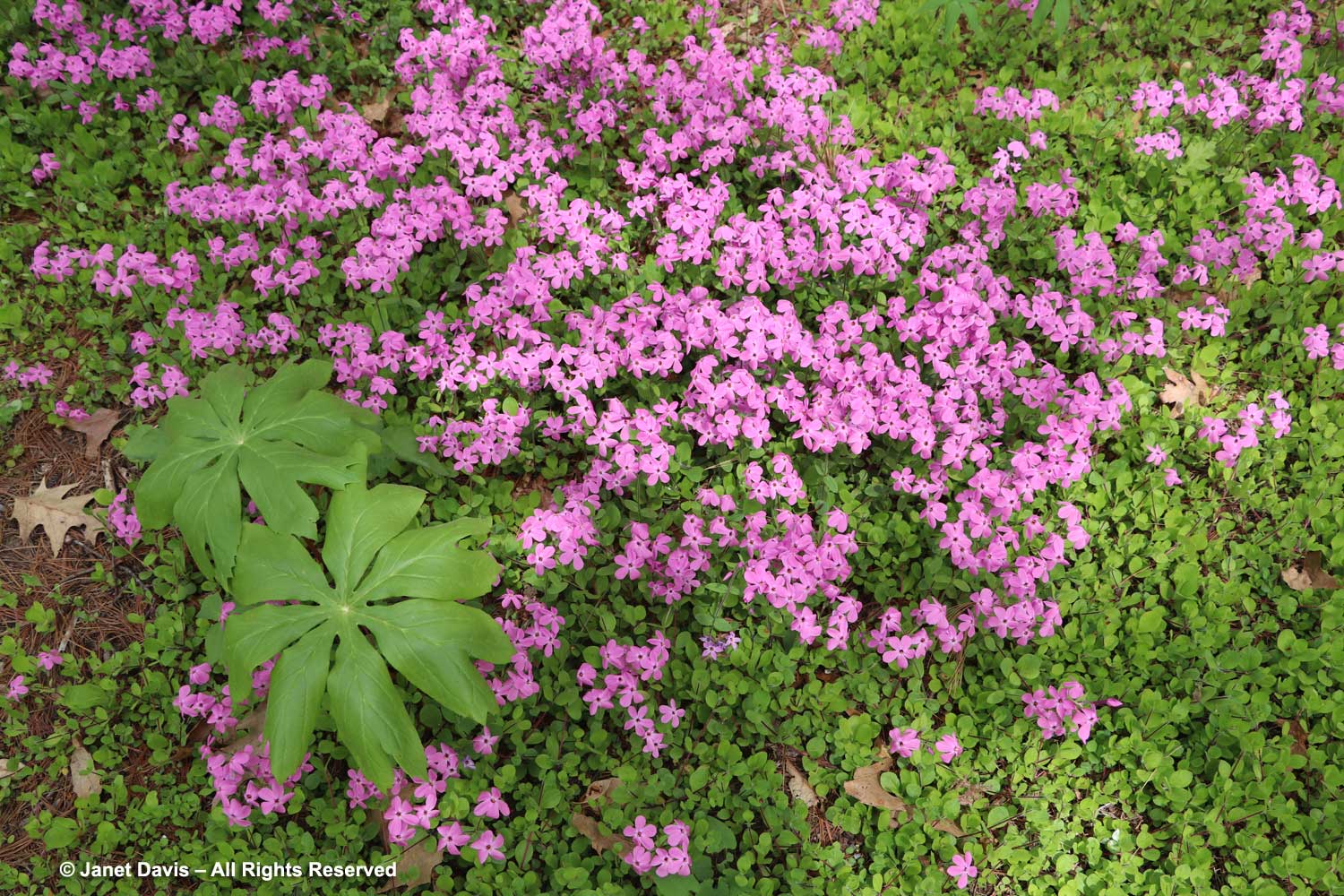
I see my second trillium, yellow wakerobin (T. luteum)….
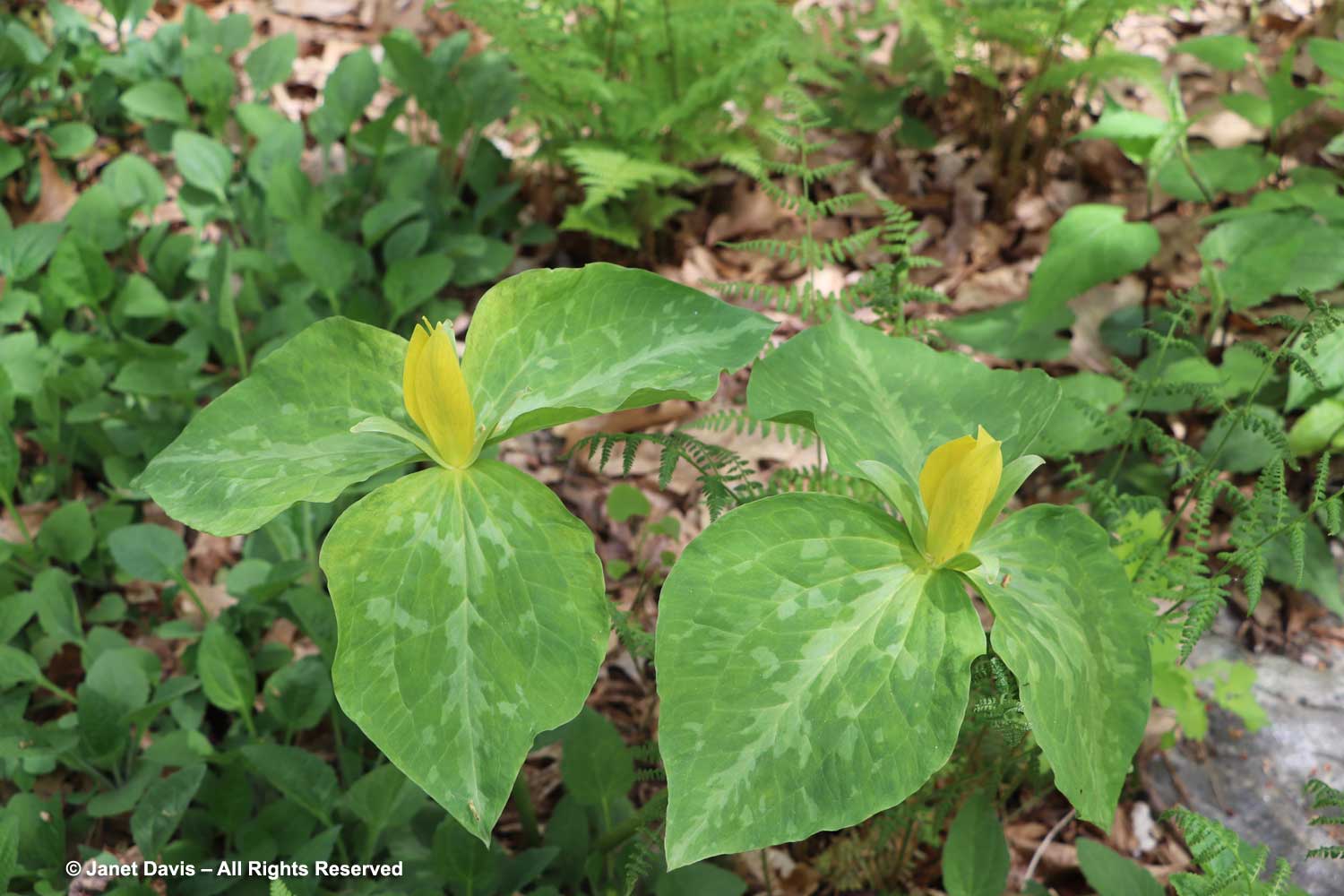
…. and note how lovely it looks with the pink creeping phlox.
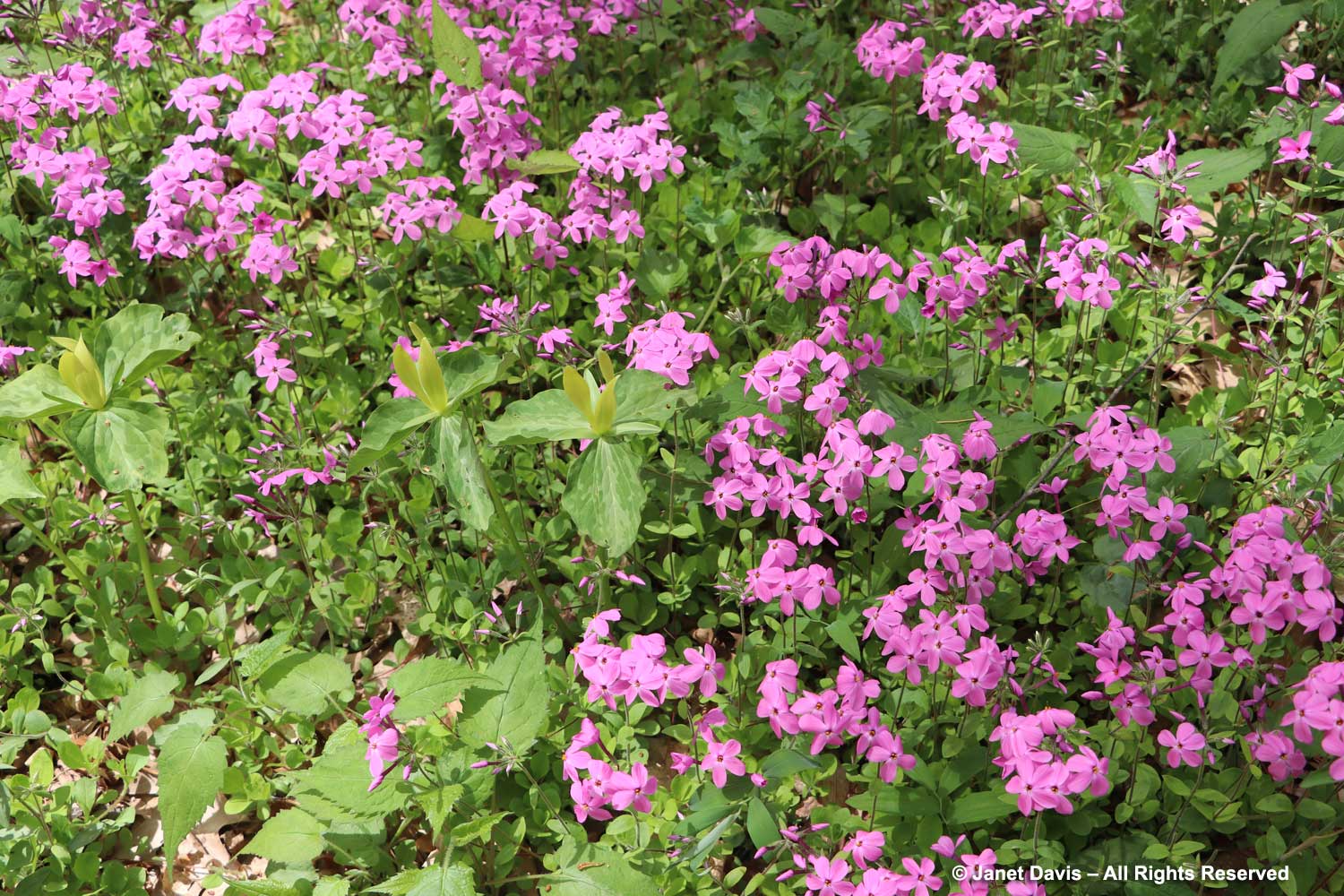
We pass by Carolina rhododendron (R. carolinianum)….
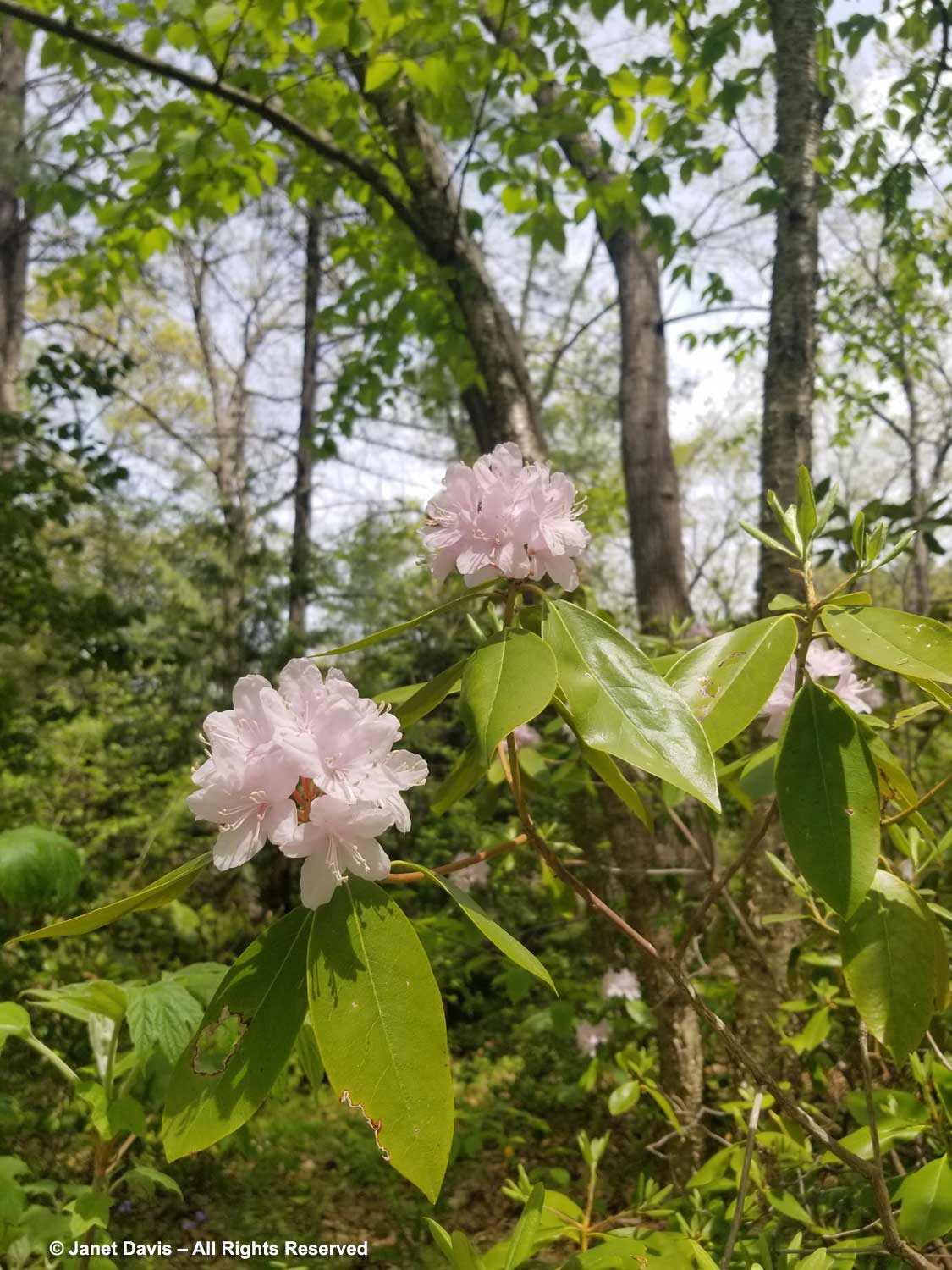
…. and Piedmont rhododendron (R. minus)…..
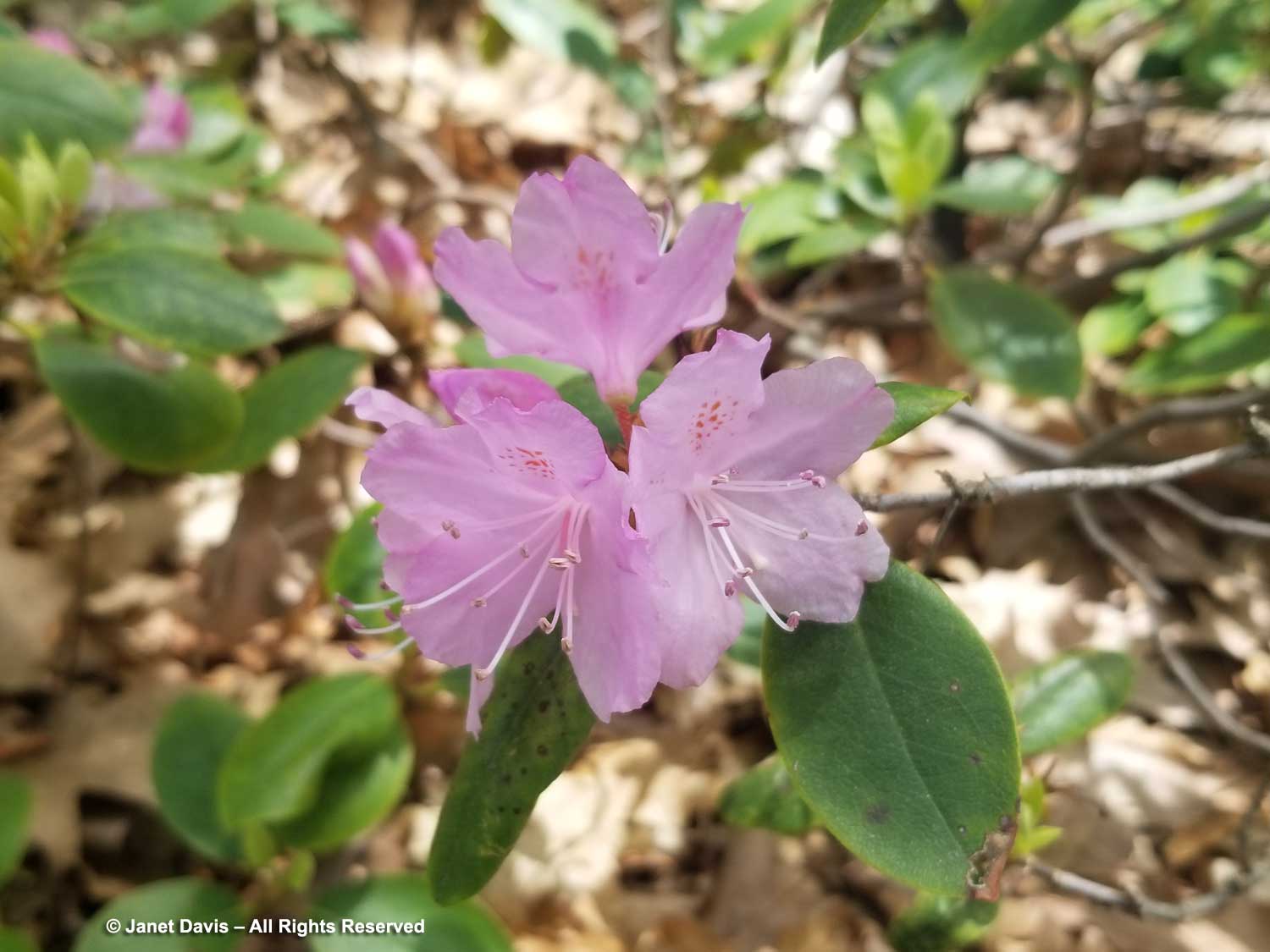
…. under towering yellow birch trees (Betula allegheniensis). The birdsong here is amazing.
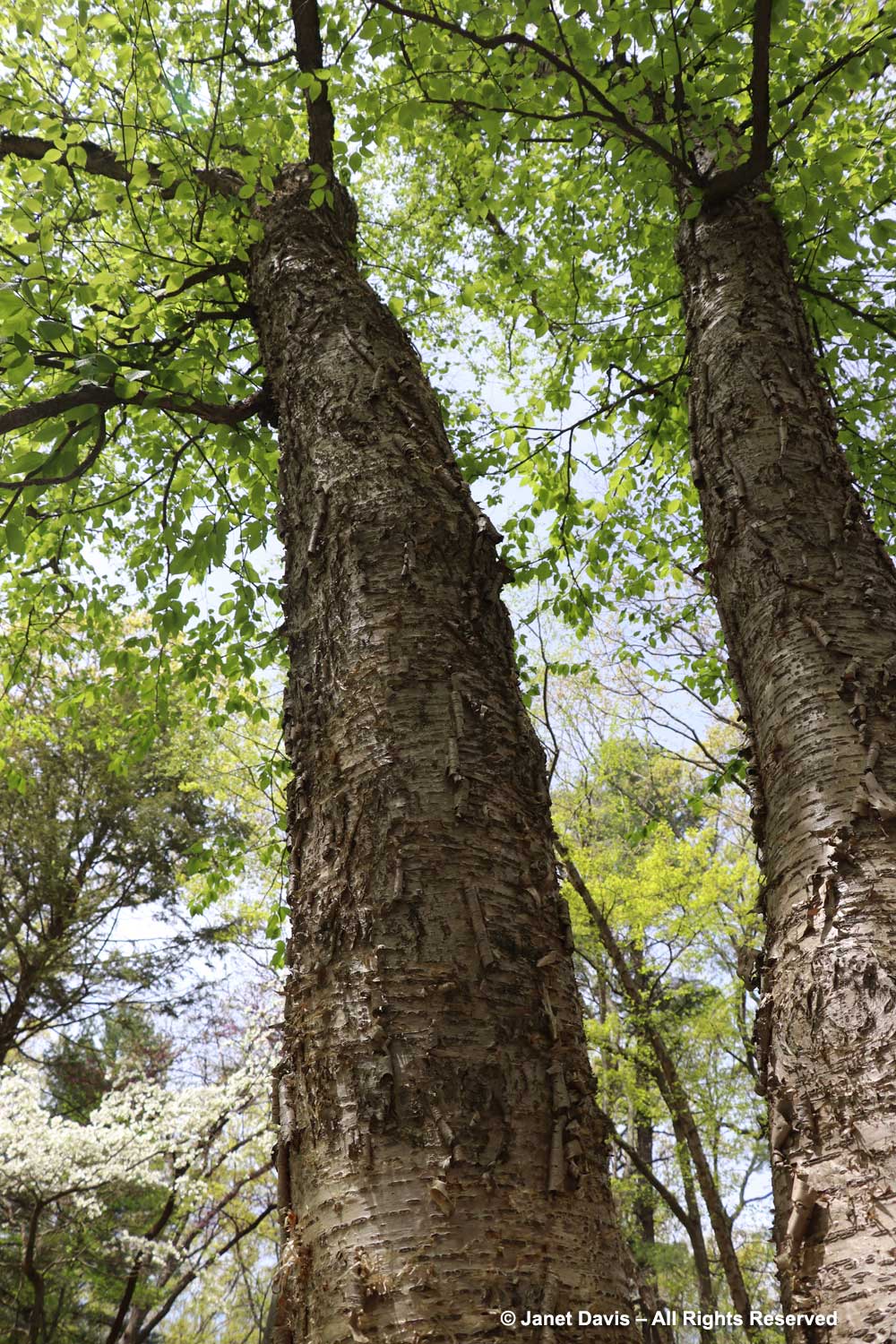
We descend to a valley (though this entire part of New England is referred to as the Connecticut River Valley) and the topography hints clearly at the property’s use as a gravel quarry a century ago. There’s a little enclave with a stone wall that acts to retain the hillside above….
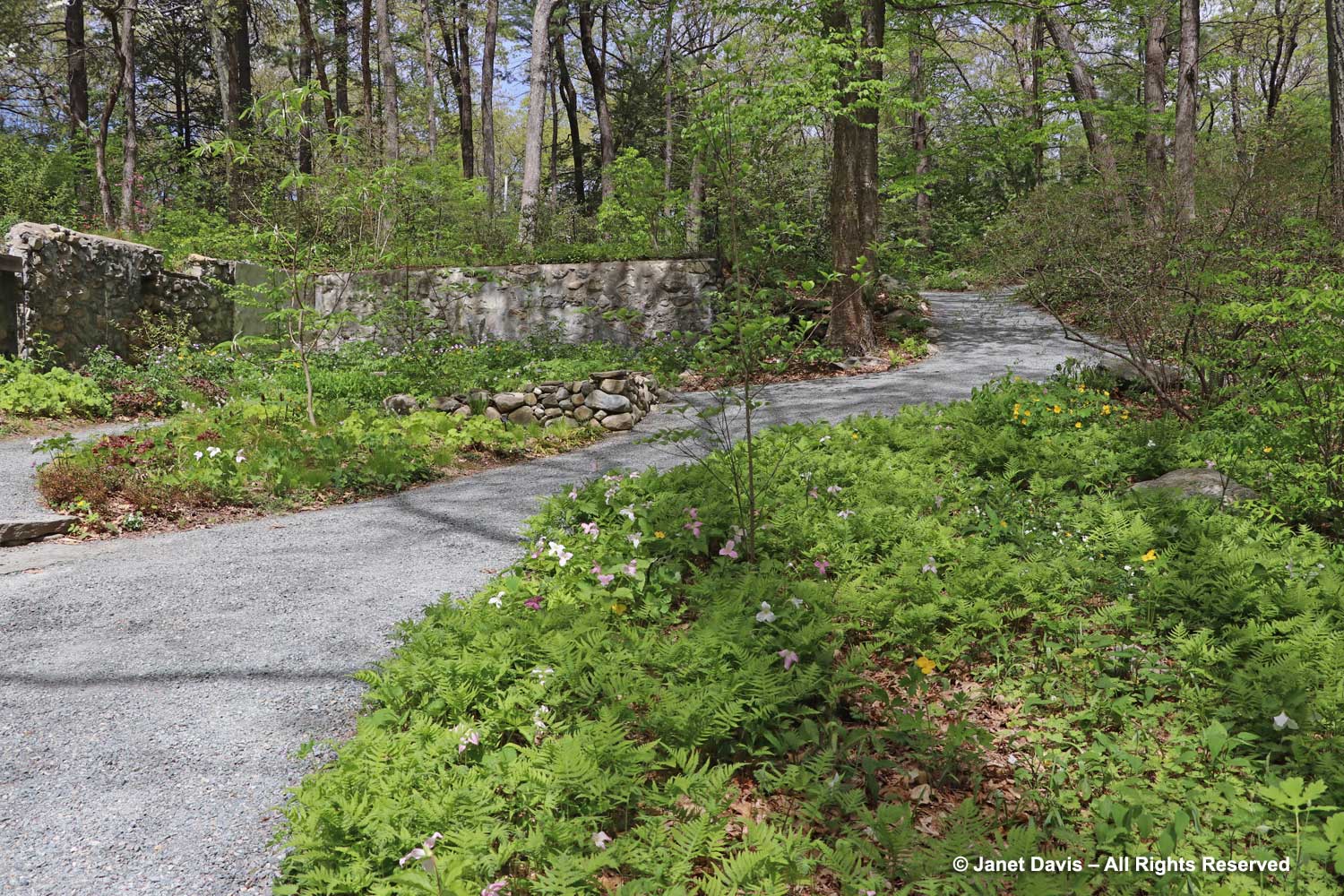
…. and a stone bench where visitors can sit and contemplate the native flora.
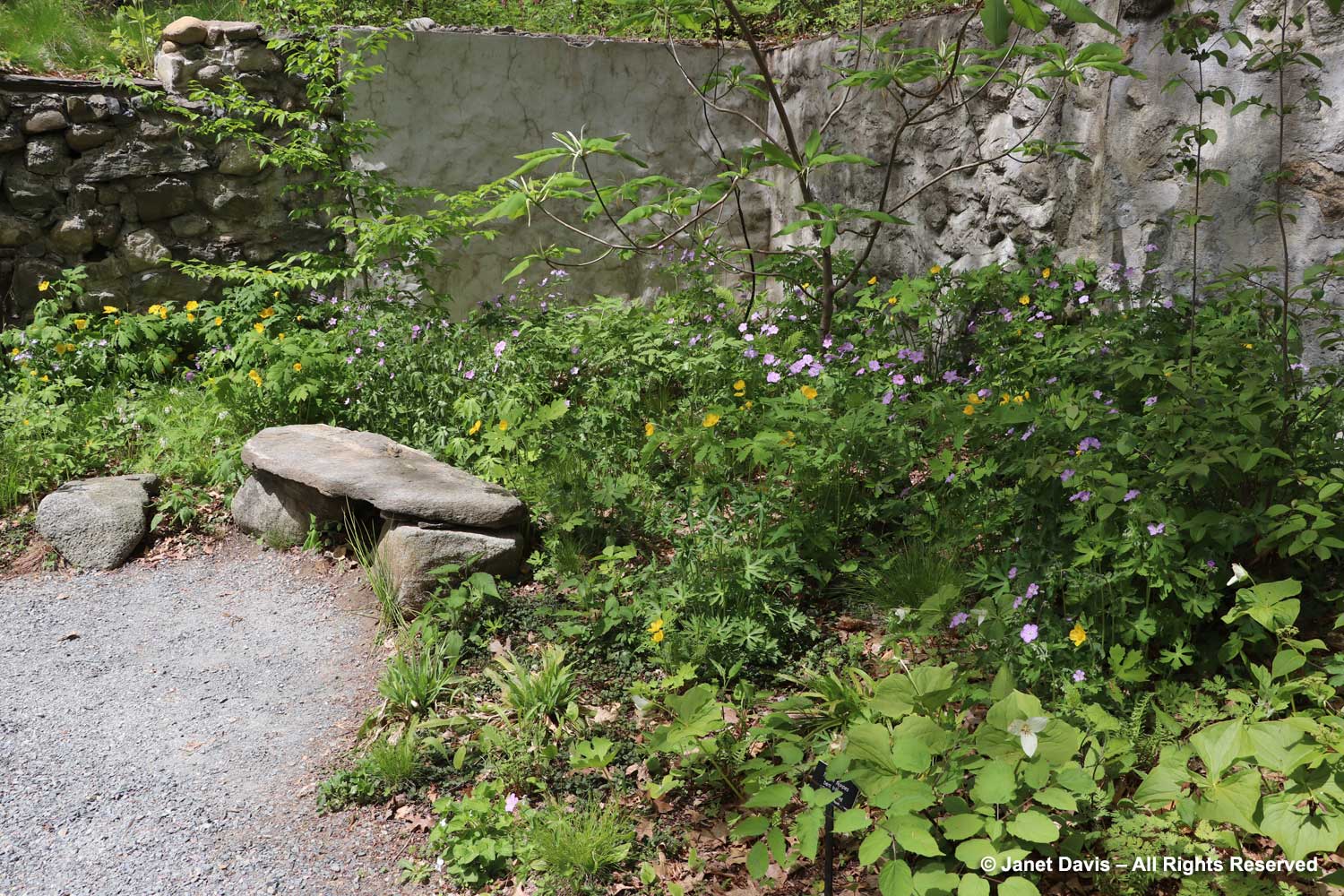
And here I find a treasure trove of trilliums, including bent trillium (T. flexipes) and…
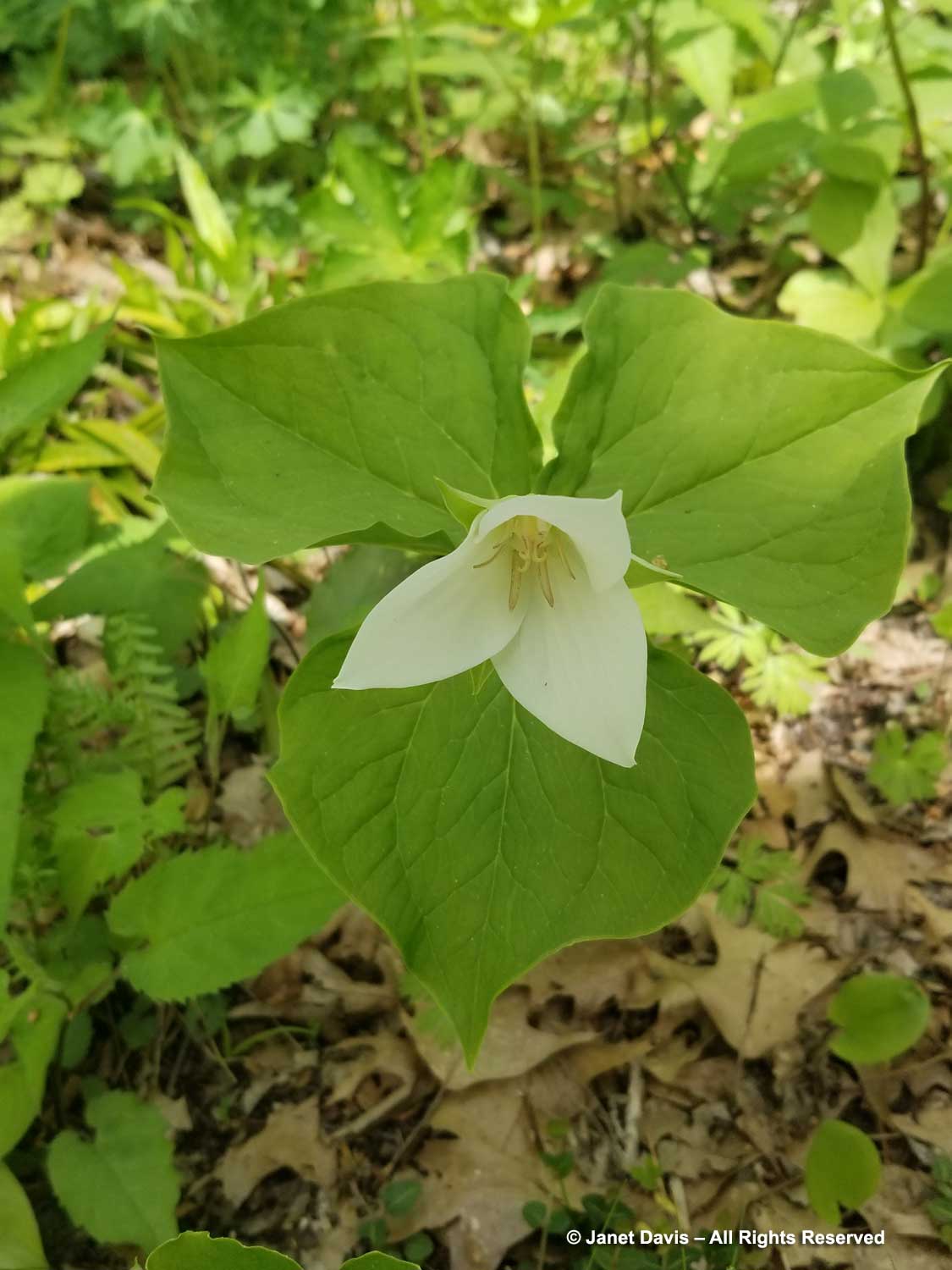
….the pink form of showy trillium or wakerobin (T. grandiflorum var. roseum) and….
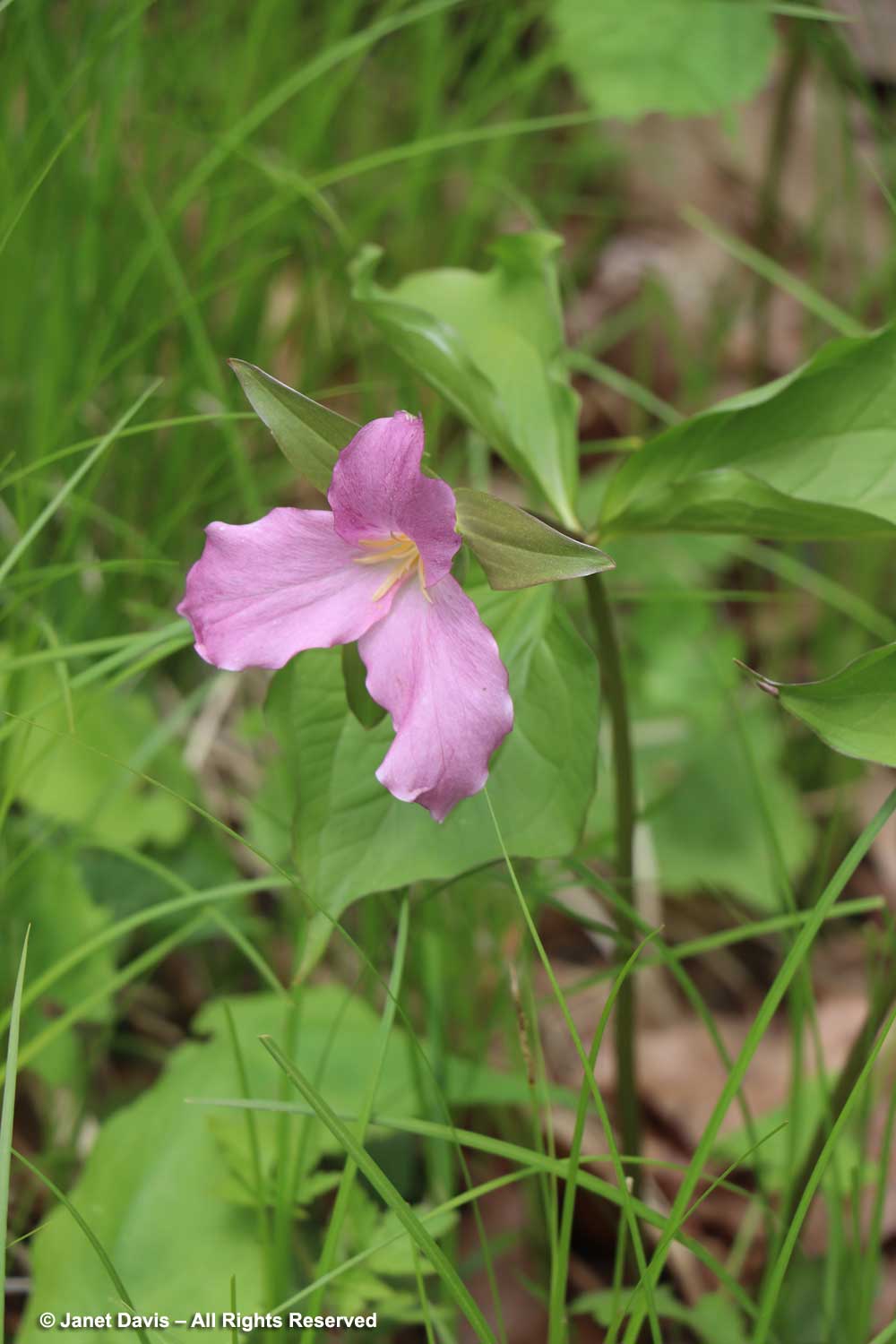
….. sweet white trillium (T. simile) and…..
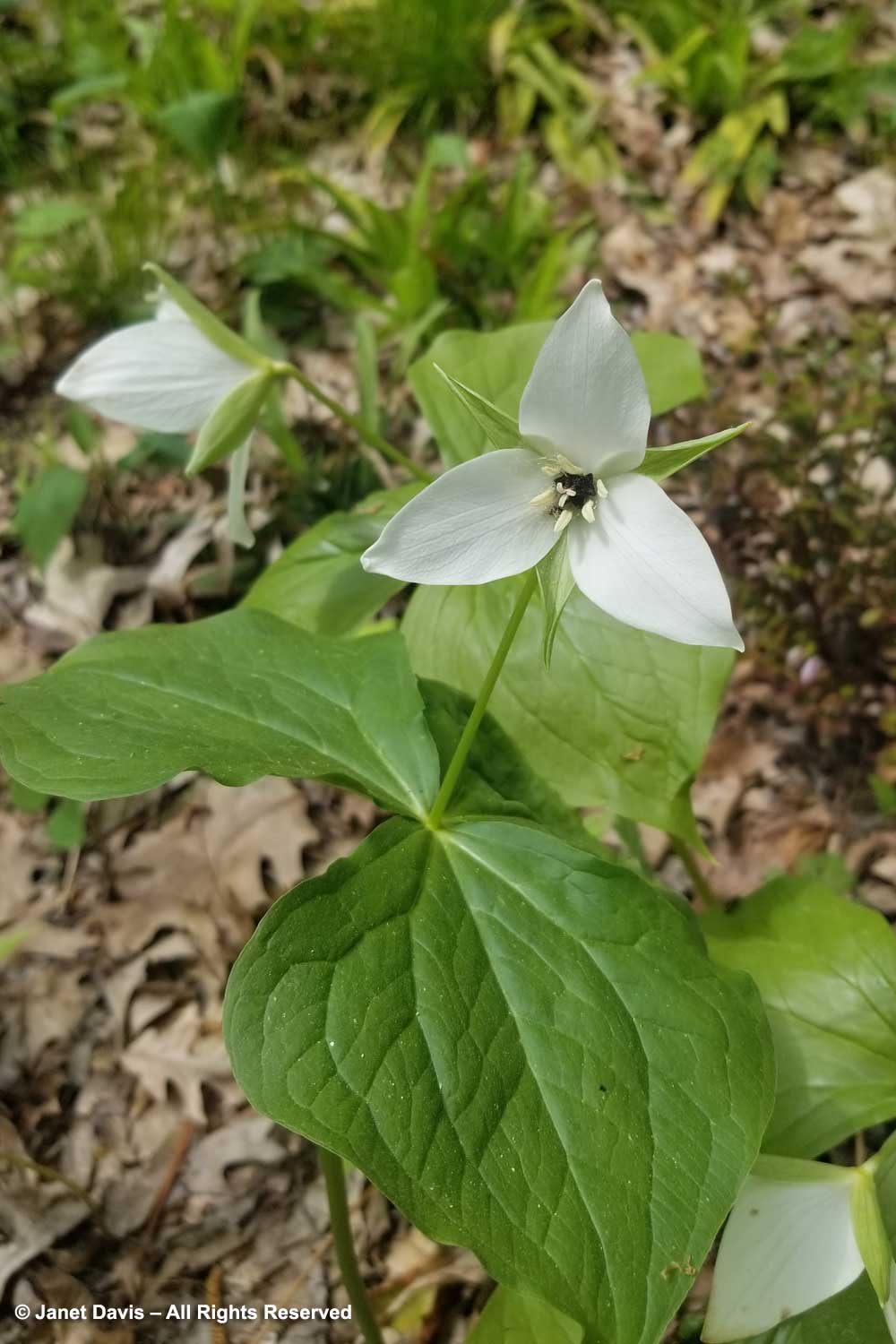
….. toadshade (T. sessile) and…..
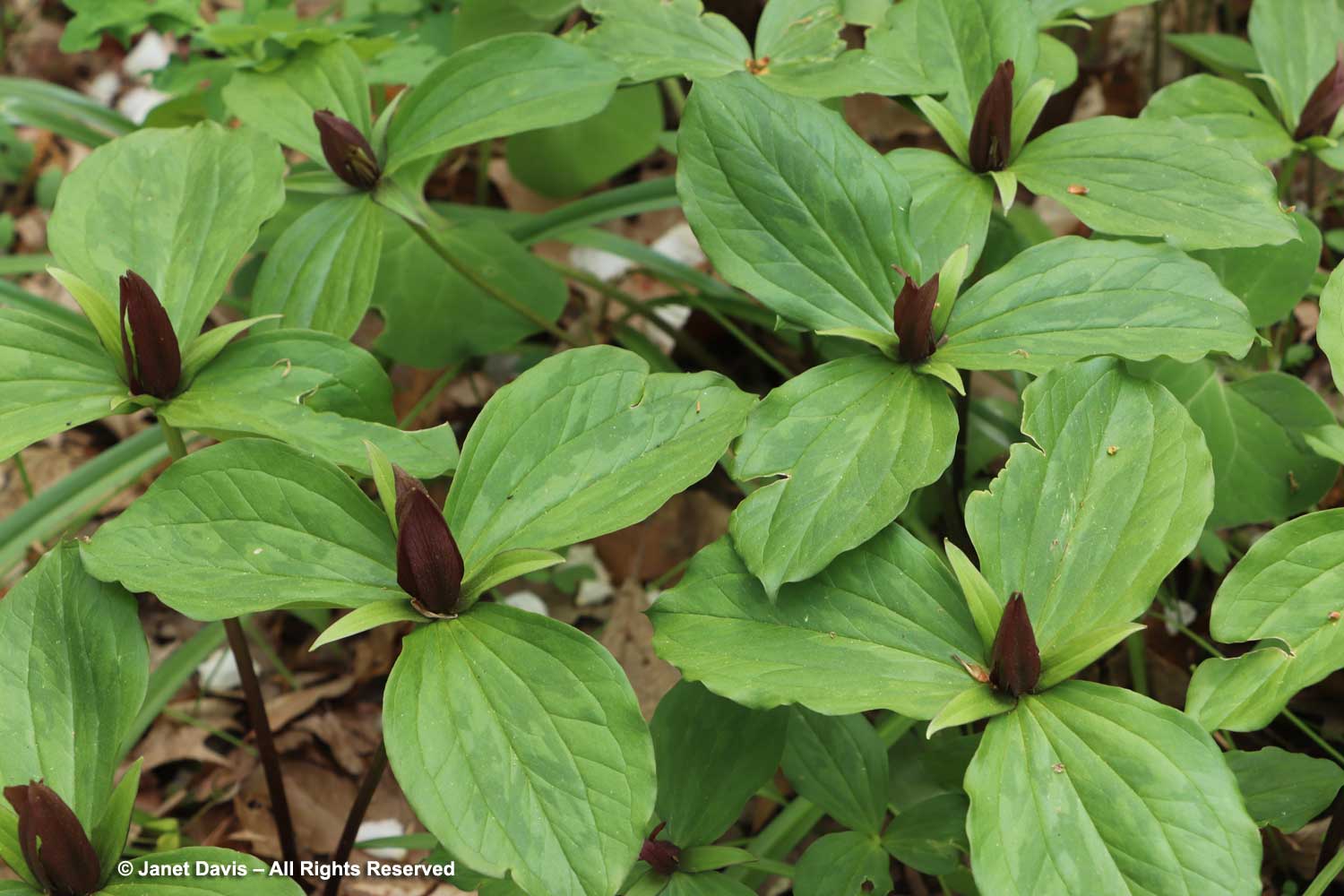
…… showy trillium (T. grandiflorum), here with long beech fern (Phegopteris connectilis)…
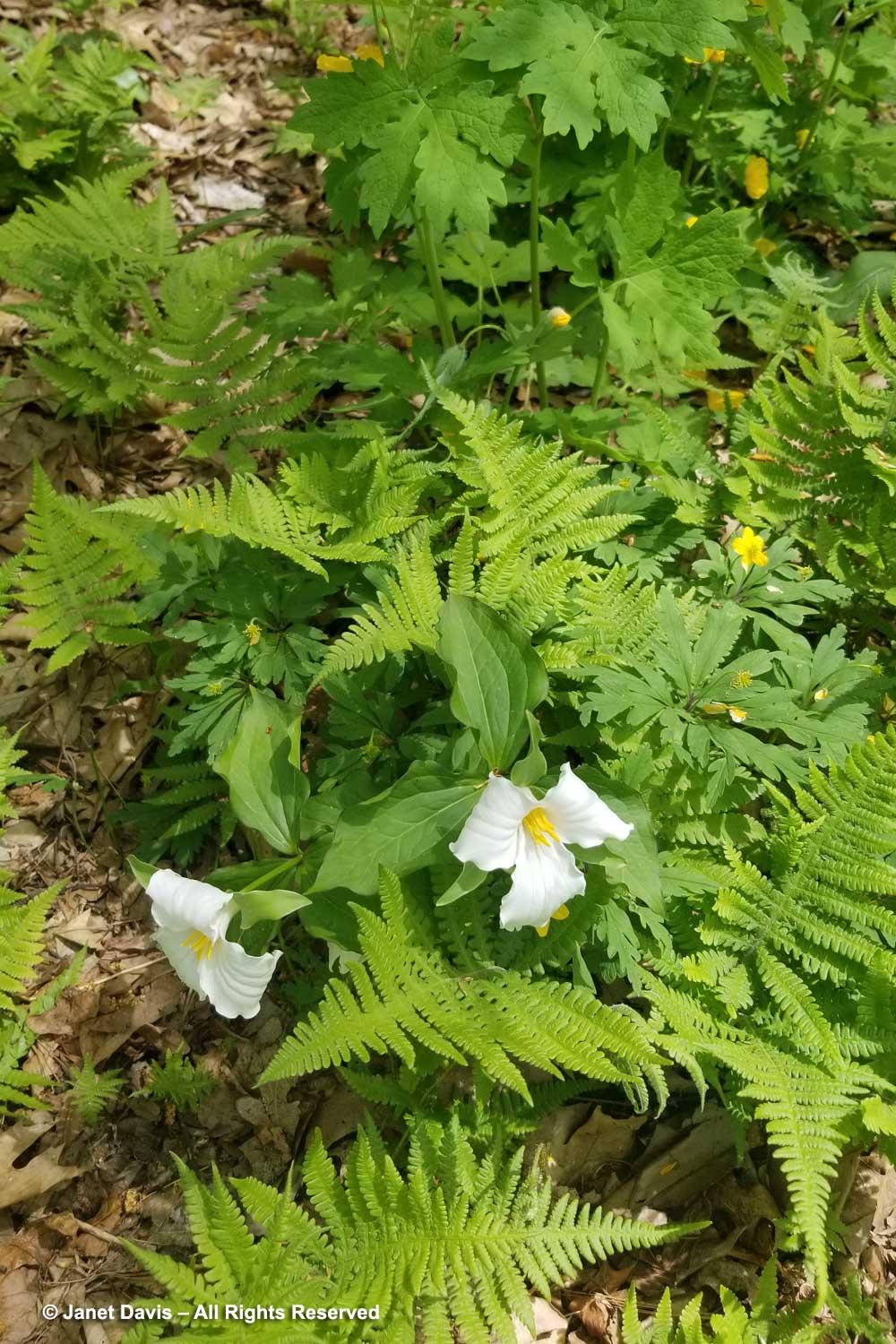
….. and finally nodding toadshade (T. cernuum).
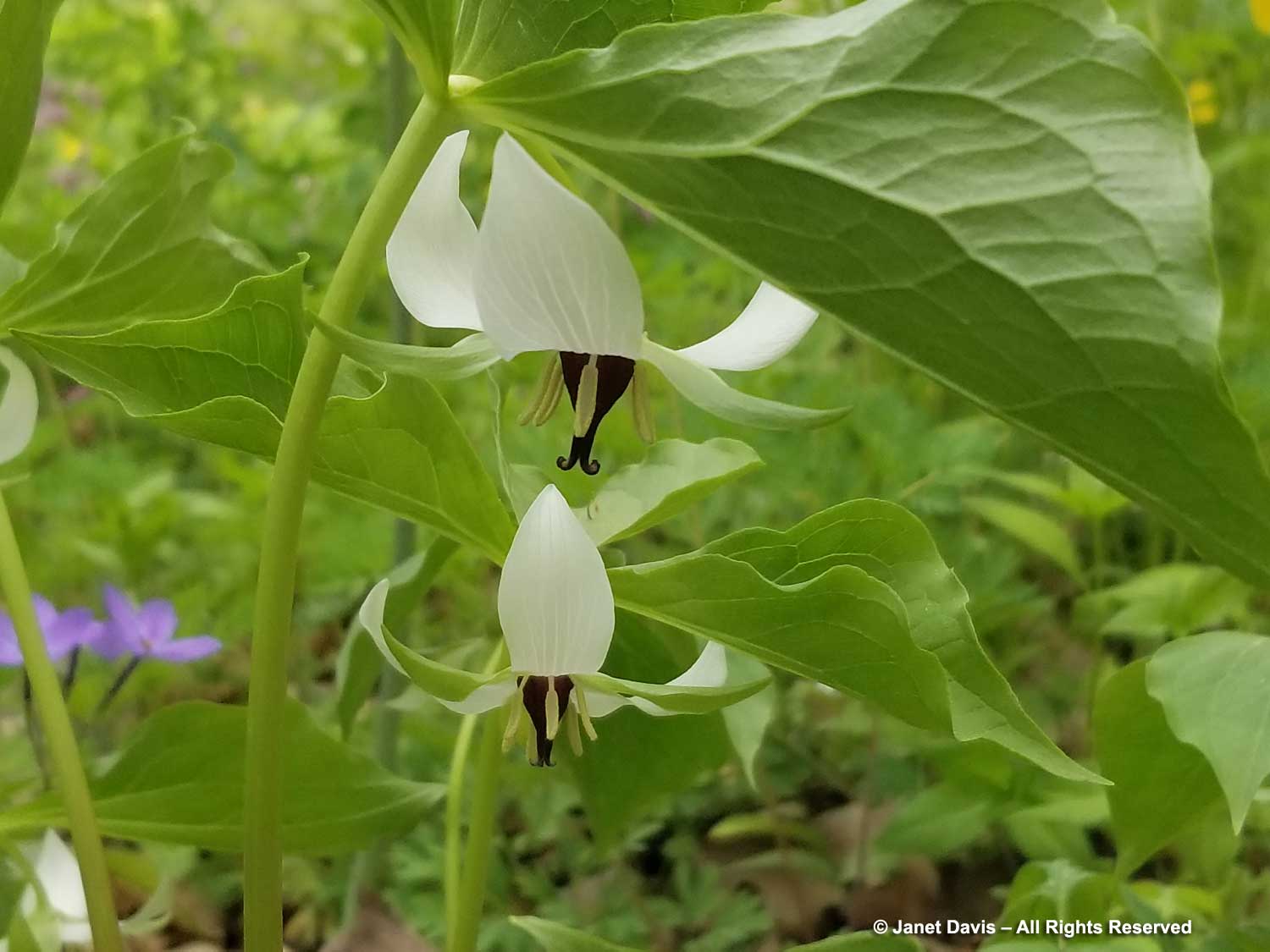
How tranquil it is here, without the hordes of visitors I expected, given the peak bloom.
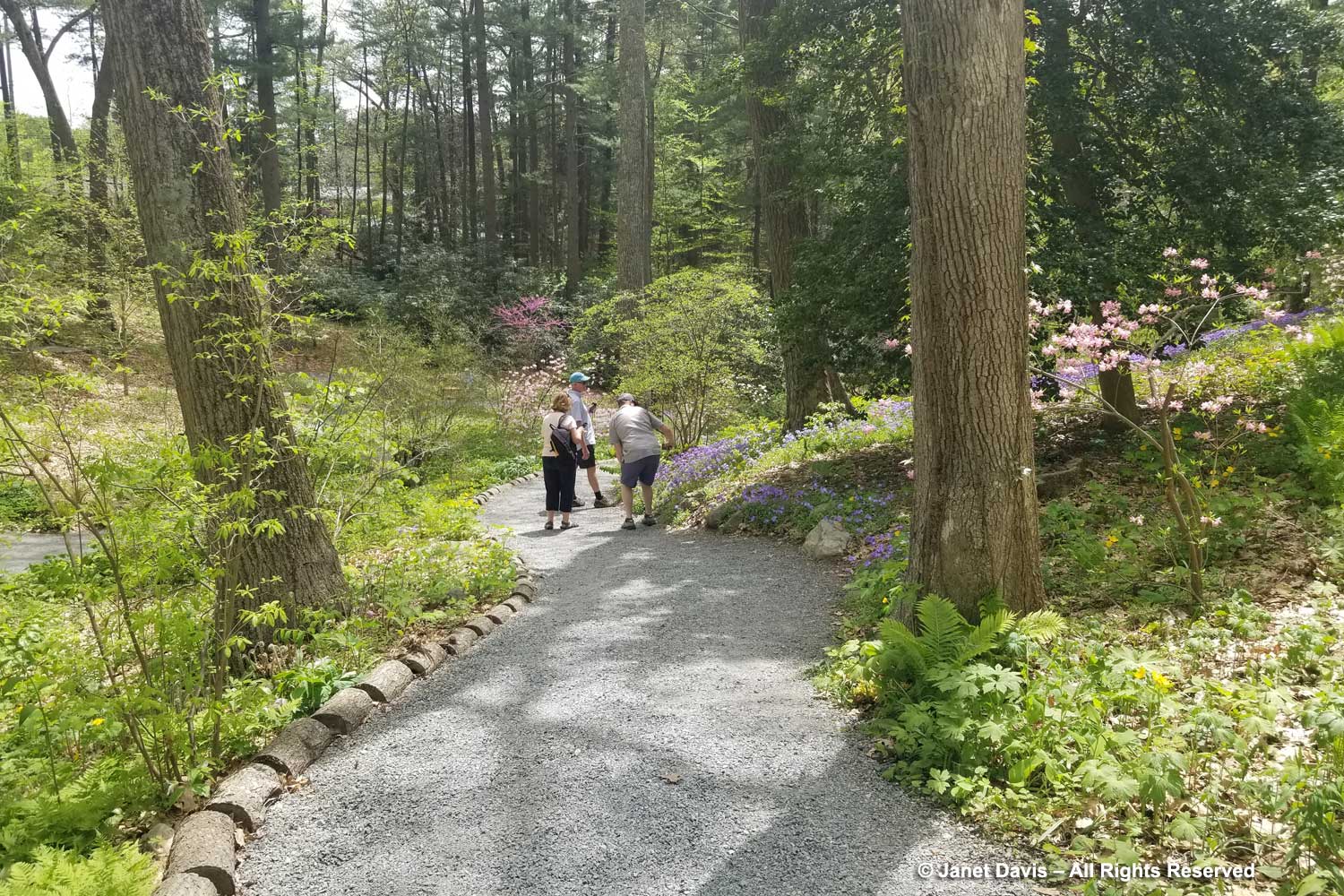
The most brilliant show at the moment is decidedly creeping phlox (P. stolonifera). I believe this is ‘Sherwood Purple’…..
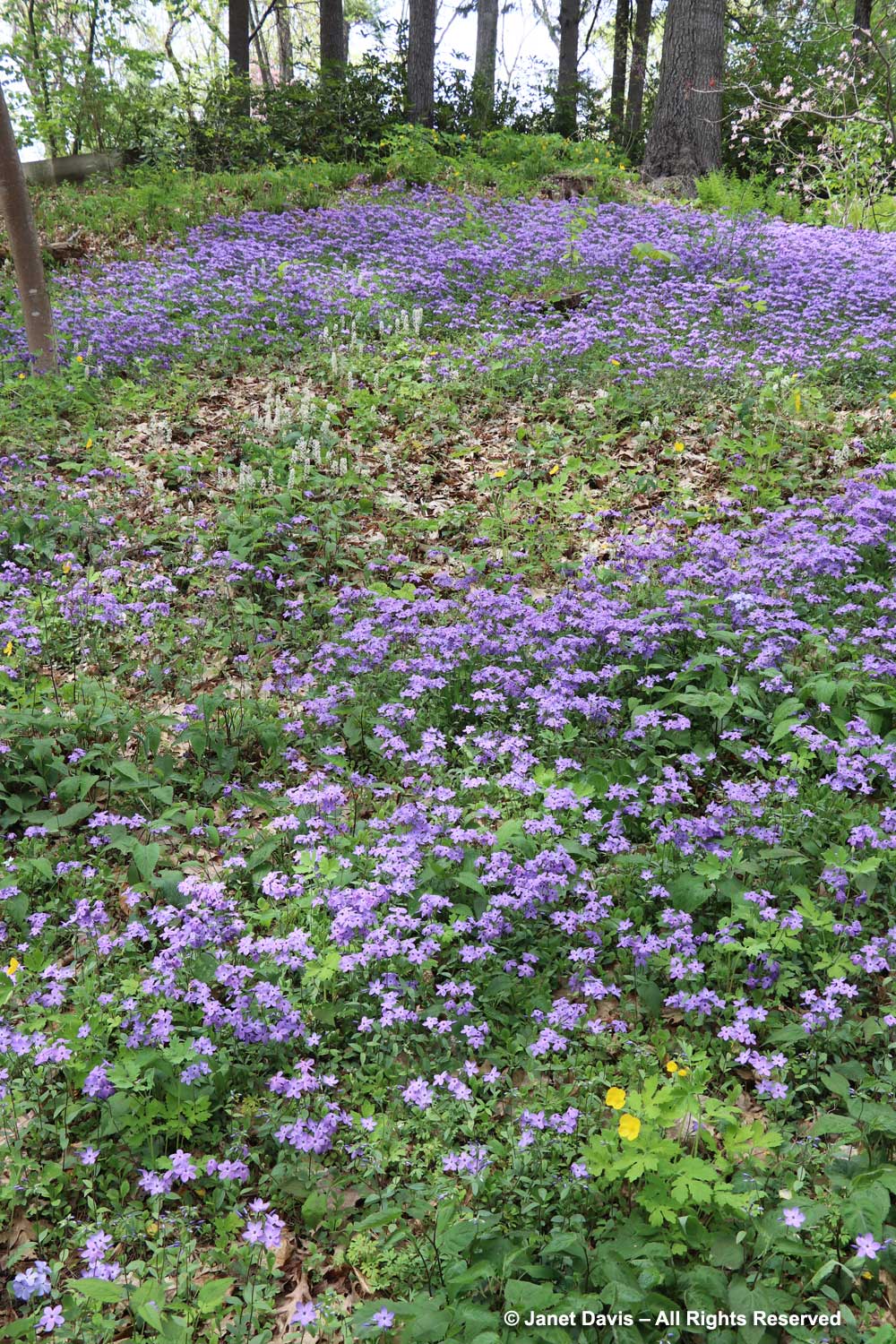
….. pairing beautifully with yellow wood poppy (Stylophorum diphyllum) in one area….
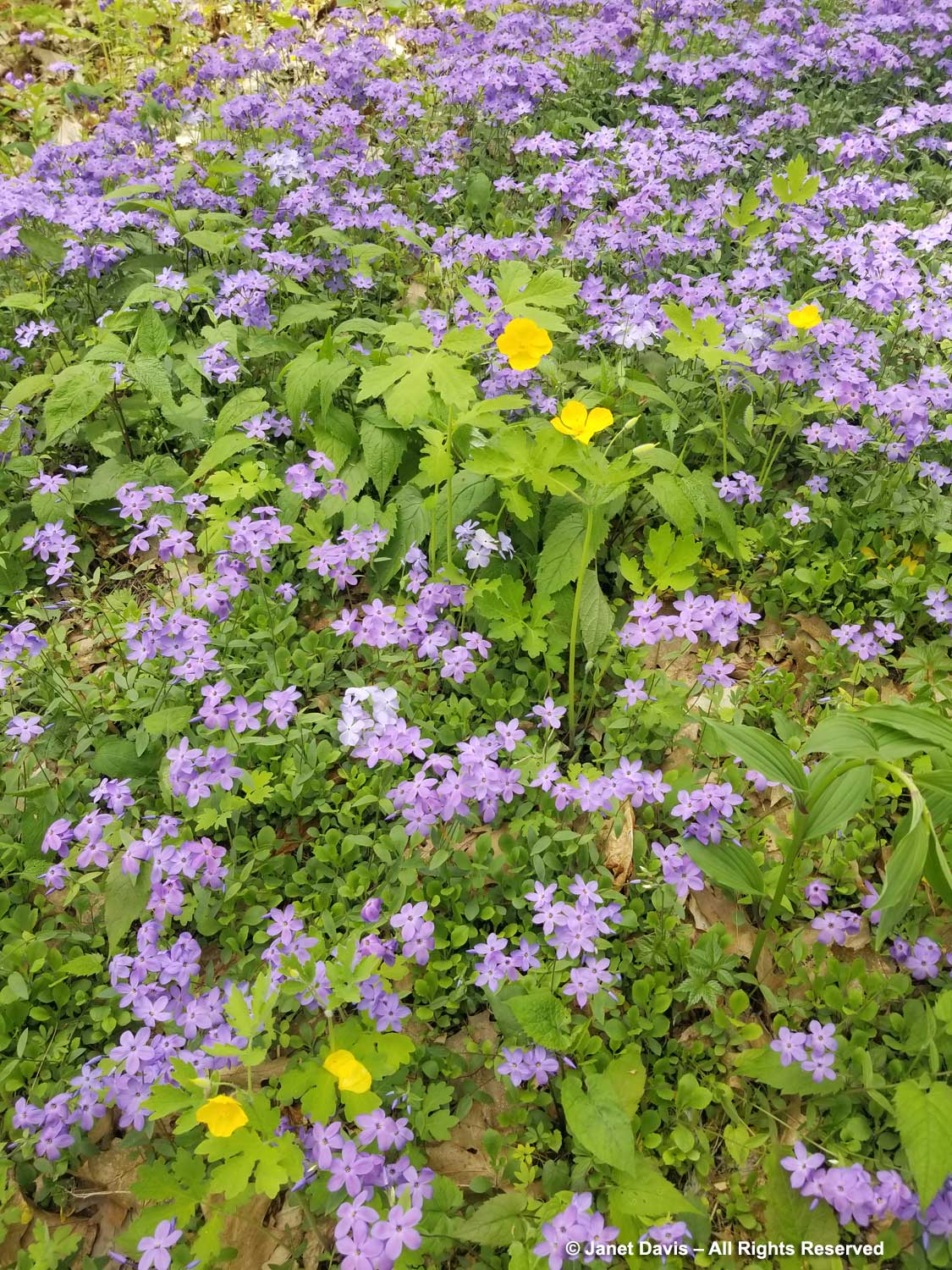
….. and foamflower (Tiarella cordifolia) in another.
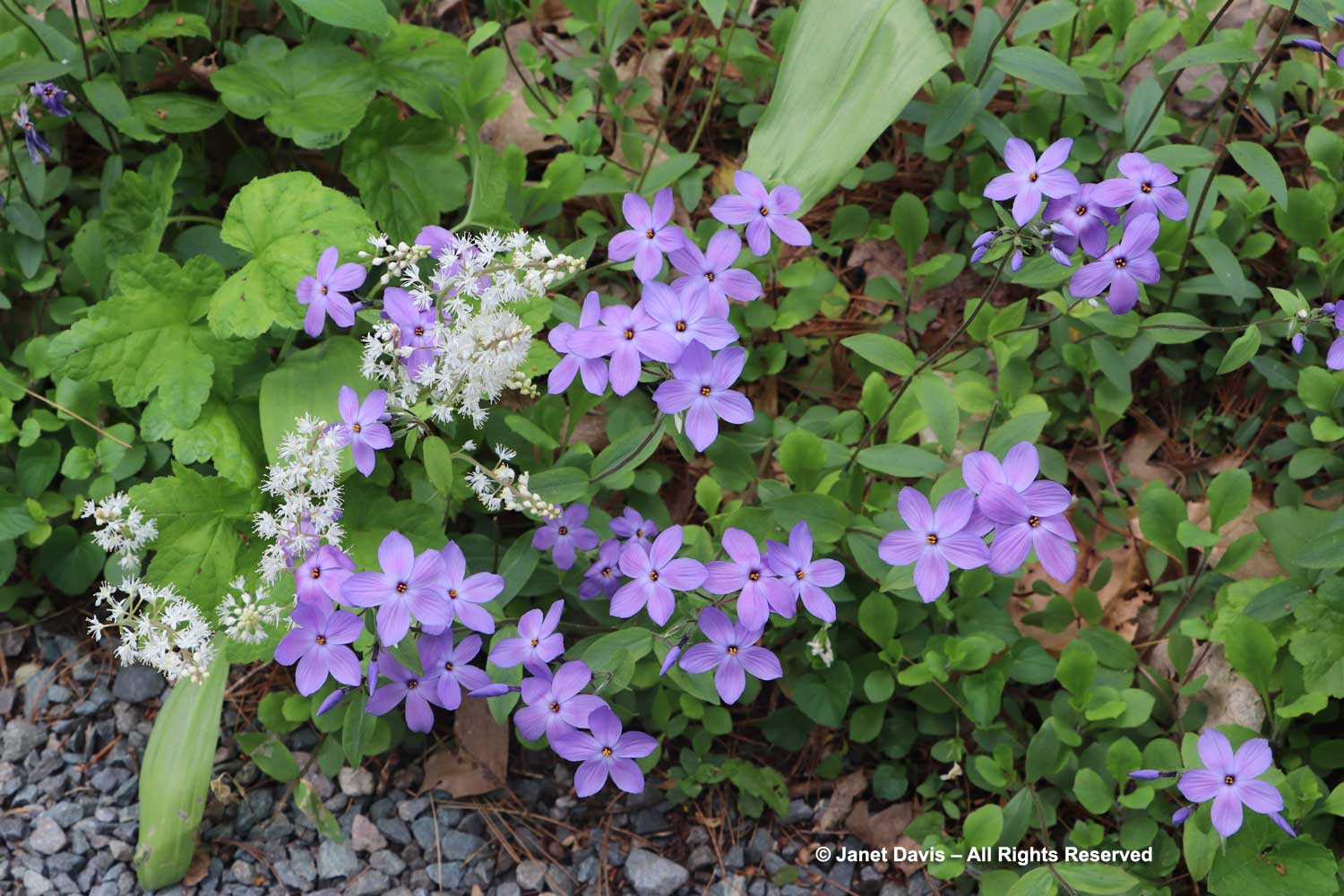
I see one of my own garden’s… um… more aggressive plants, ostrich fern (Matteucia struthiopteris) looking quite well-behaved in the midst of creeping phlox. Perhaps all I need are a few dozen gardeners to help me control it?
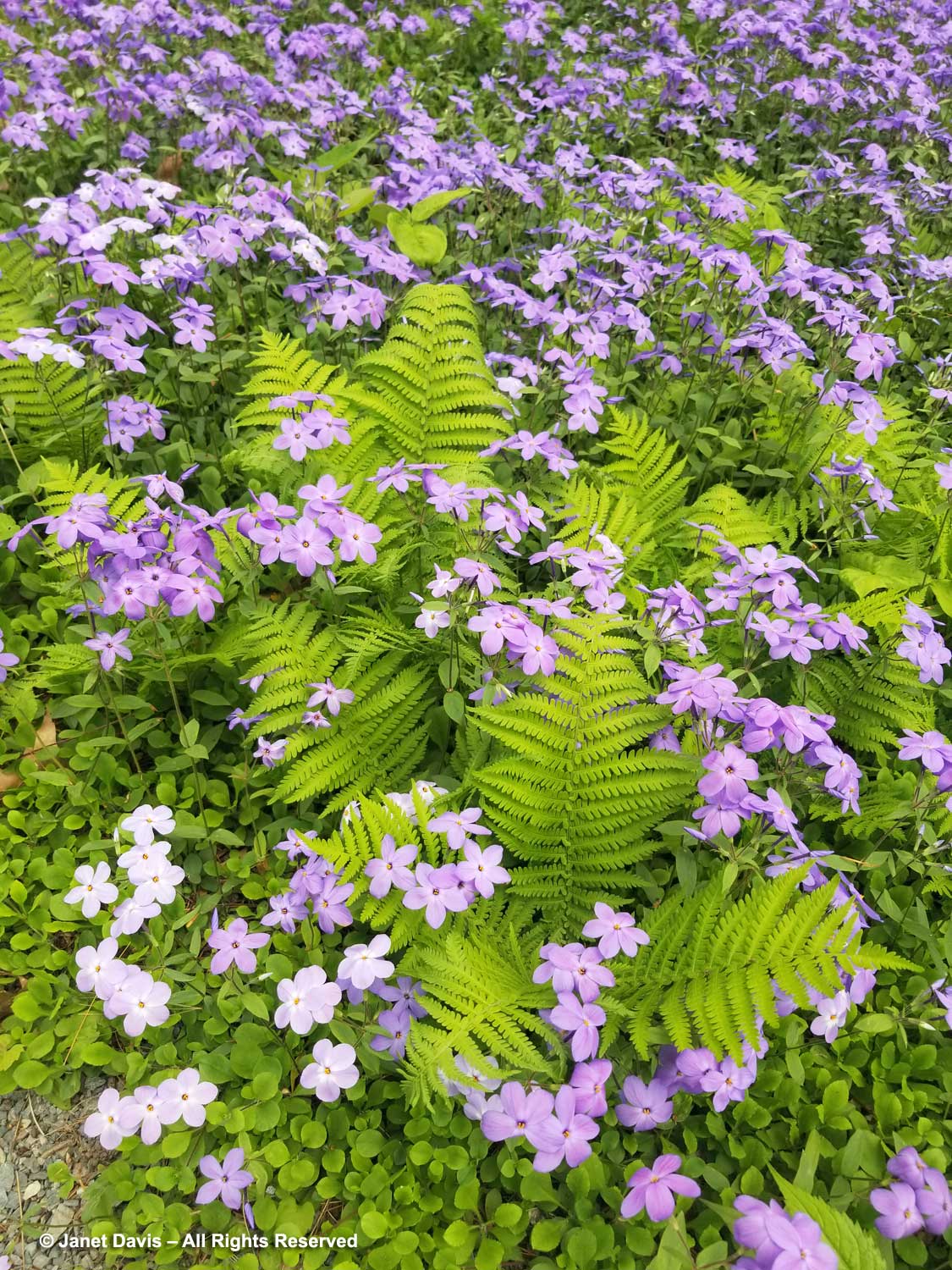
A little andrena bee is foraging on star chickweed (Stellaria pubara).
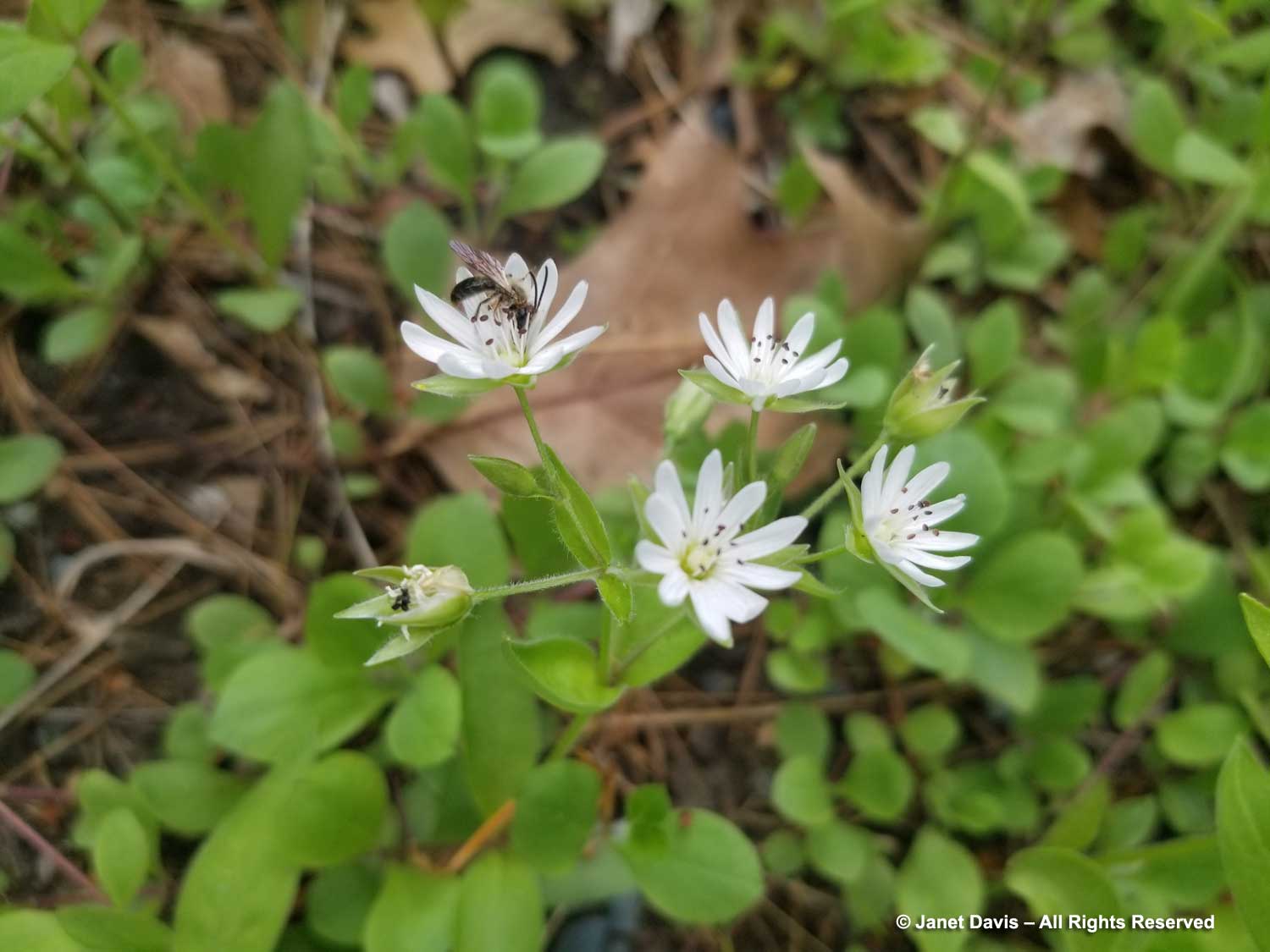
I find fringed bleeding heart (Dicentra eximia) down here, both the light-pink form…
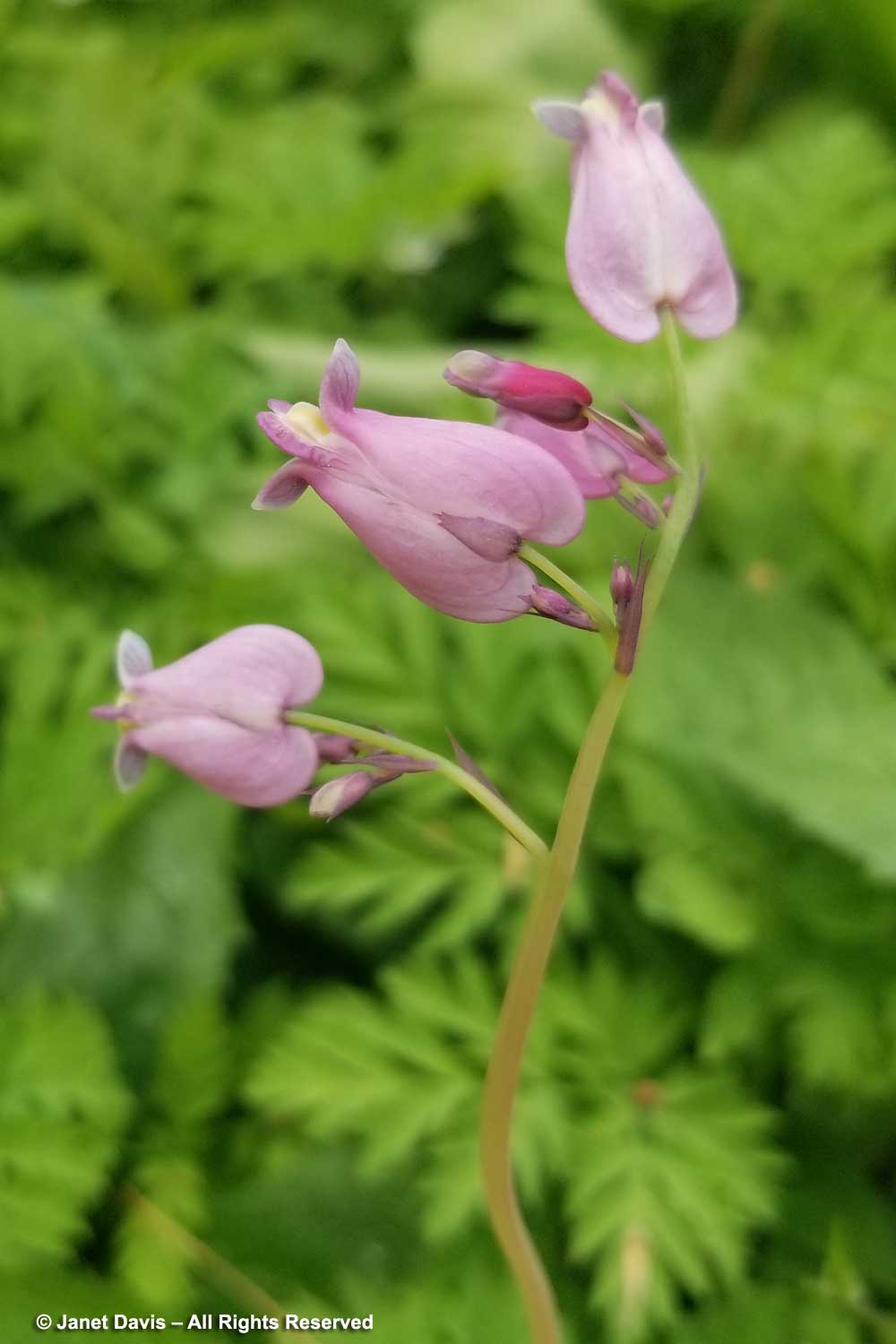
…. and a raspberry-pink form, here with wild leeks (Allium tricoccum).
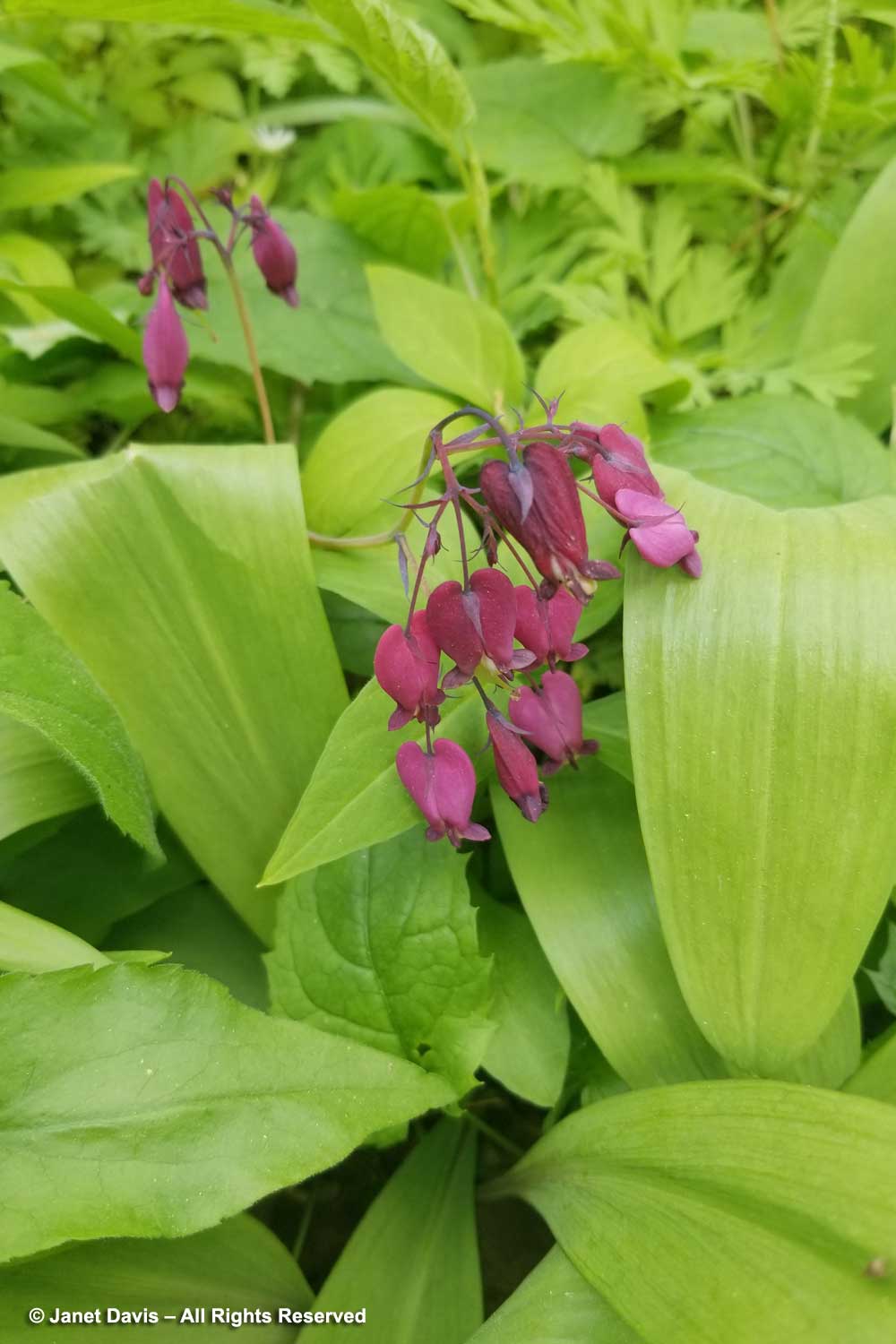
Look at this valley. Isn’t it stunning?
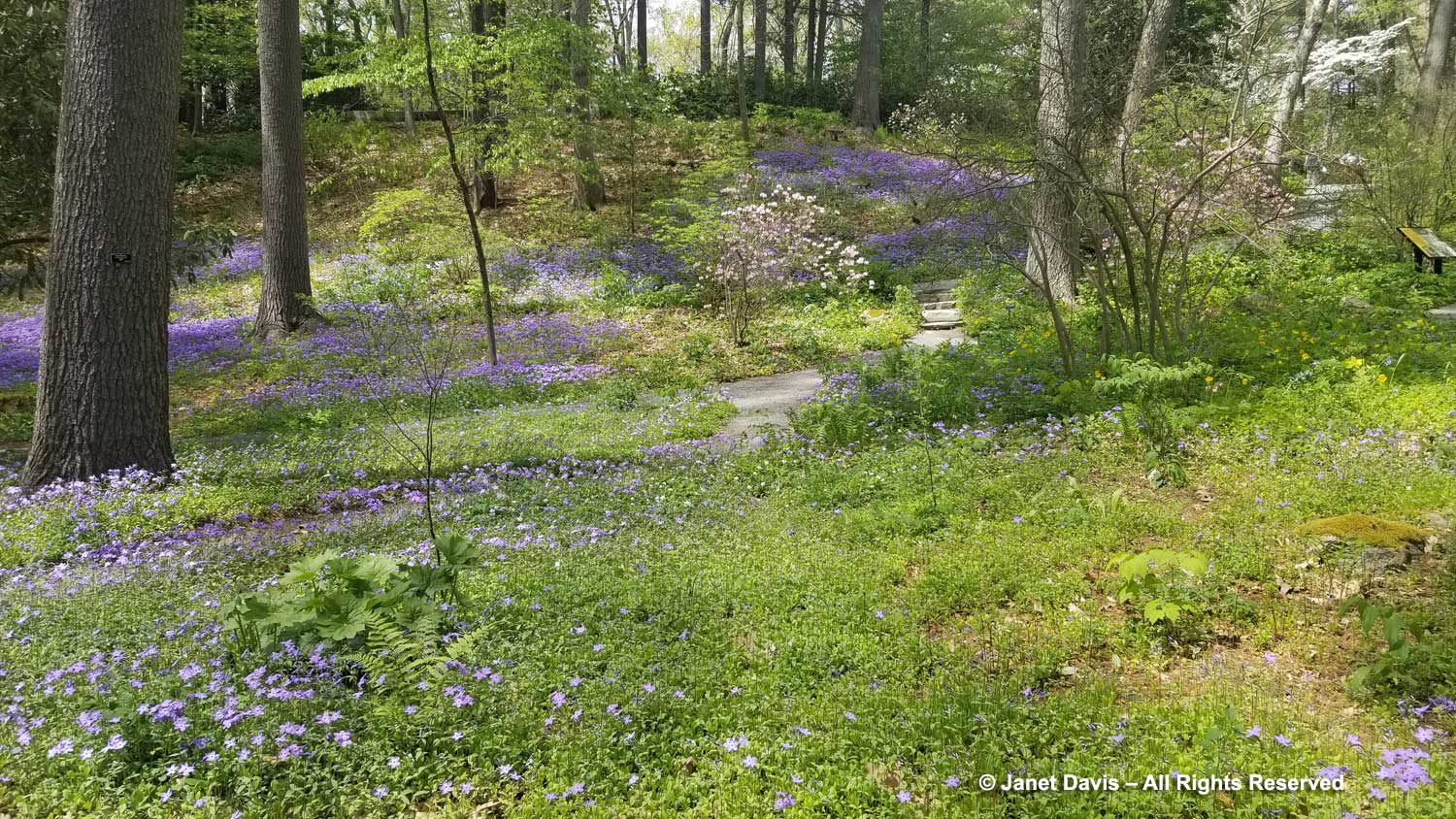
We’re now at the Rock Garden and I find Phlox subulata ‘Emerald Cushion Blue’ making good use of the outcrops.
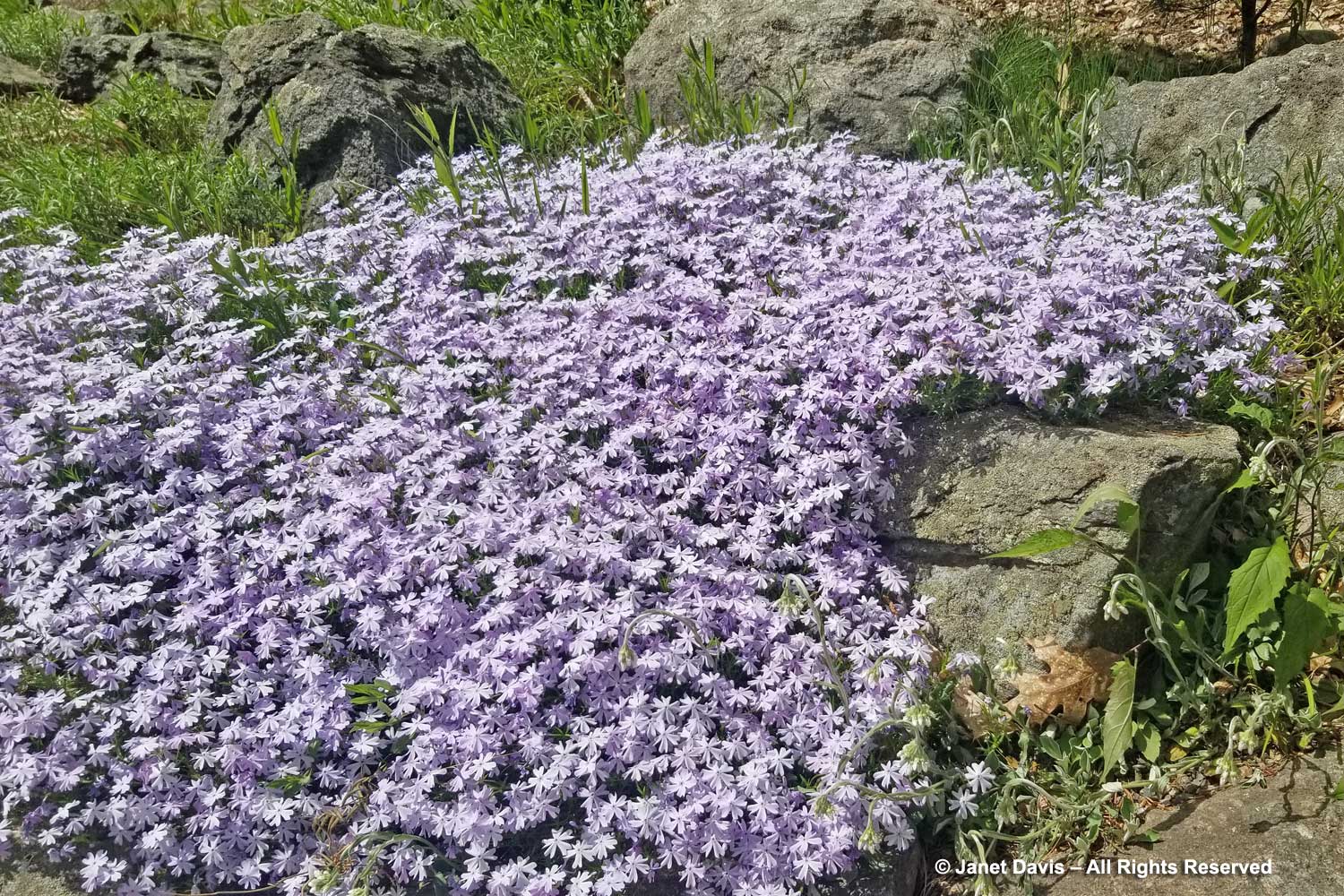
Nearby is a little colony of plaintain-leaf pussytoes (Antennaria plantaginifolia). Like all members of the genus, its leaves are a larval food for the American painted lady butterfly (Vanessa virginiensis).
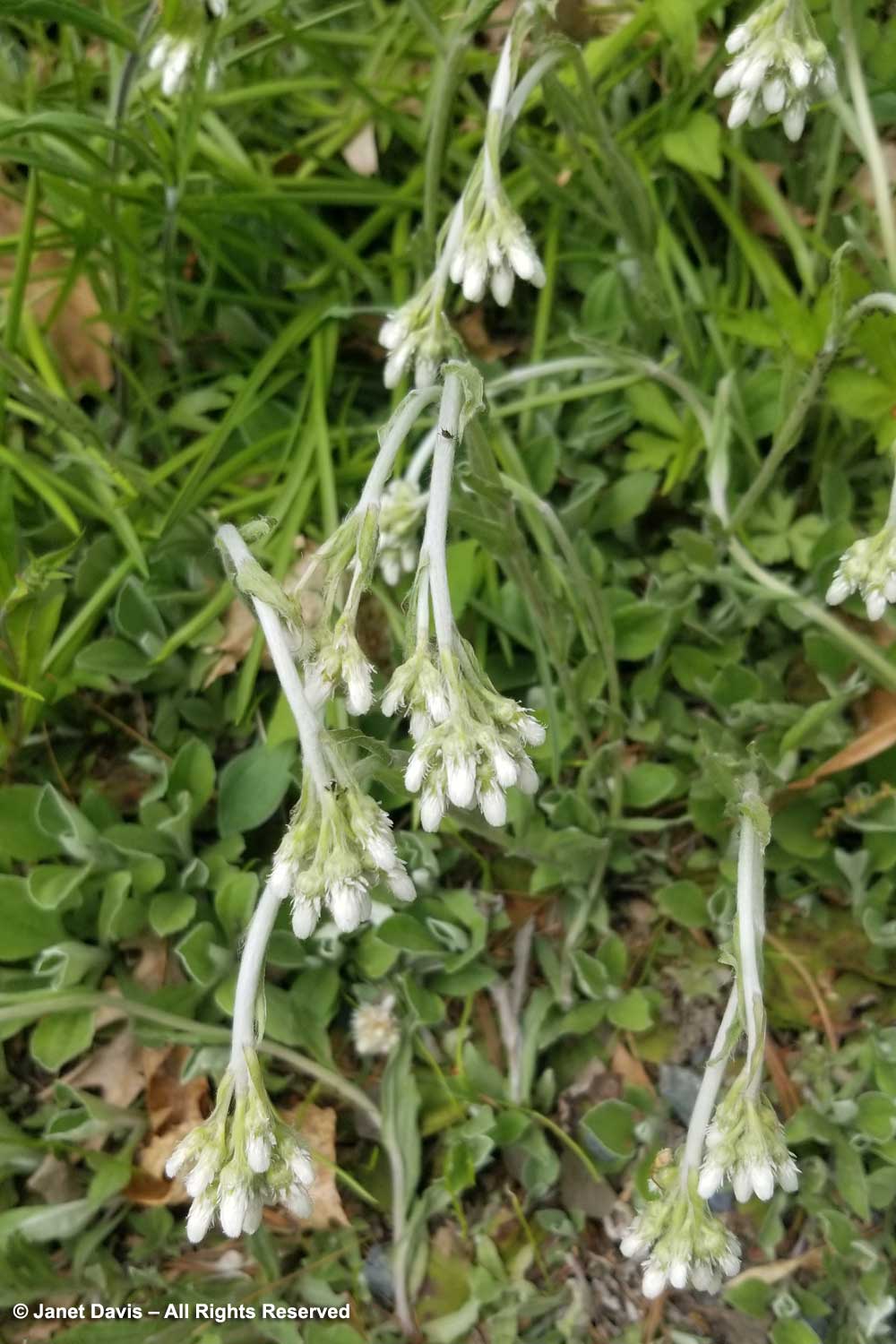
And a new-for-me plant, stiff amsonia (A. rigida).
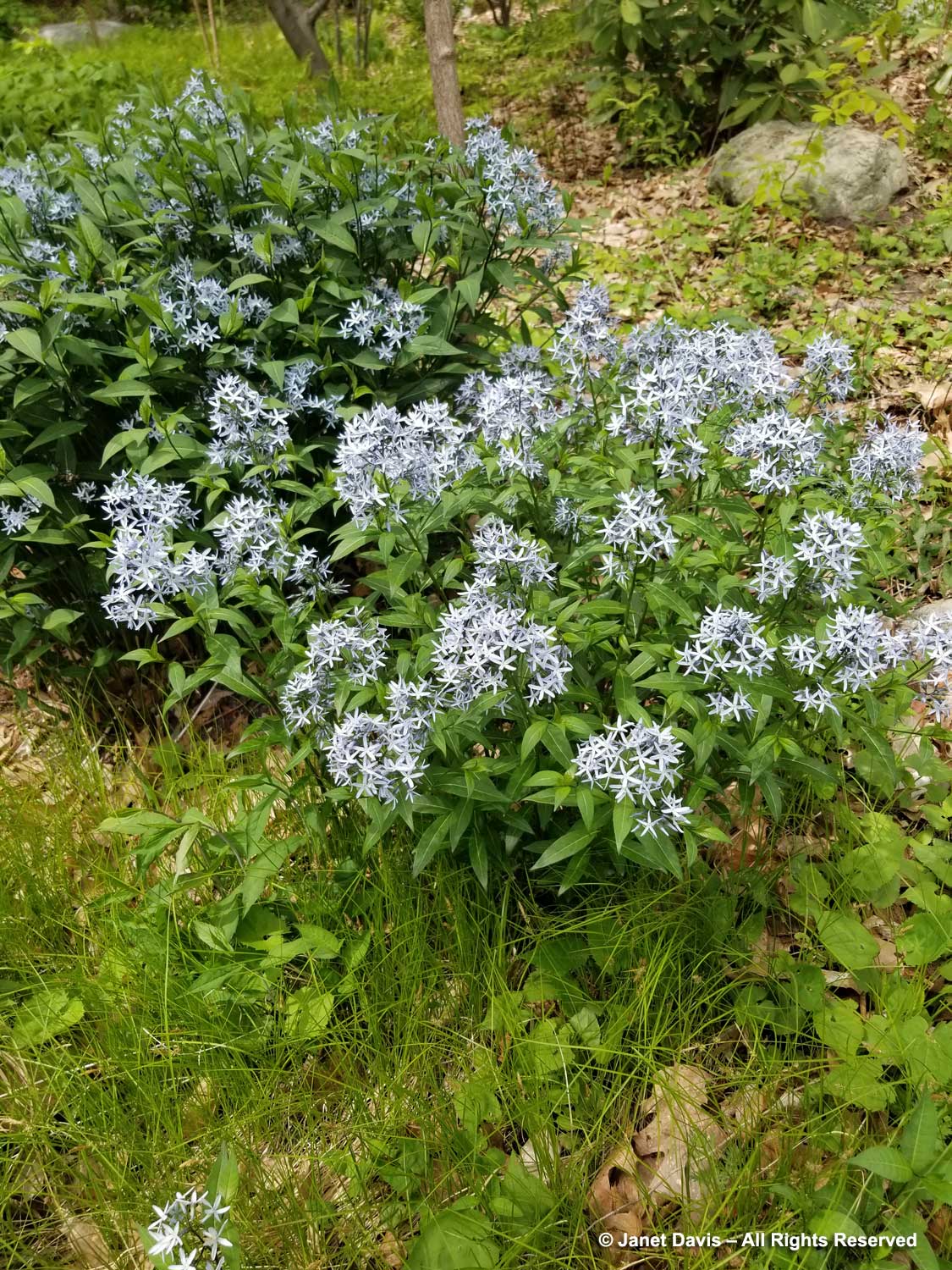
Next up is the pond… so stay tuned for Garden in the Woods – Part 2!

Love this post Janet. Like you lots of familiar plants but some new to me ones also. A friend just arrived me with three pots of Chrysogonum virginianum today and here it is in your post! i shall also be putting creeping phlox with the mayapples. I shall be saving this post, re reading and making some of the combinations in our gardens.
Donna, thank you! There are as many (more?) plants in the second post coming up in a few days.
This is extraordinary. I am a fan of Garden in the Woods and a donor and former board member to Native Plant Trust. I will save this email/blog as proof for my friends (not yet fans) who hear me gush about the organization and its Garden in the Woods.
Thank you, Thank you.
P.S. Not just an extraordinary place but an extraordinary photographer/fan. Thank you again.
Lita, thank you so much for your kind comments. I’m happy I was able to reinforce your great love for the garden. I hope you know that I wrote part 2 as well. All the best. Janet
Thank you so much for all your extremely informative posts.